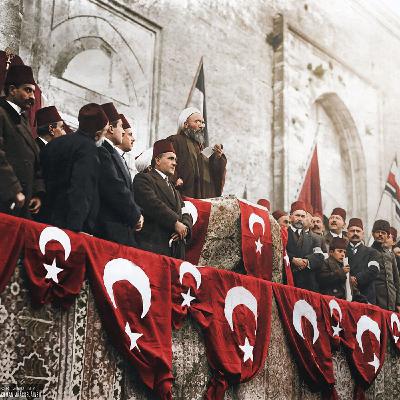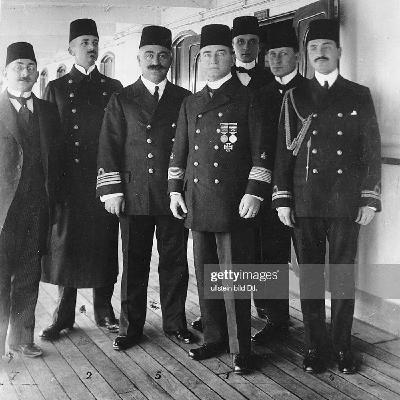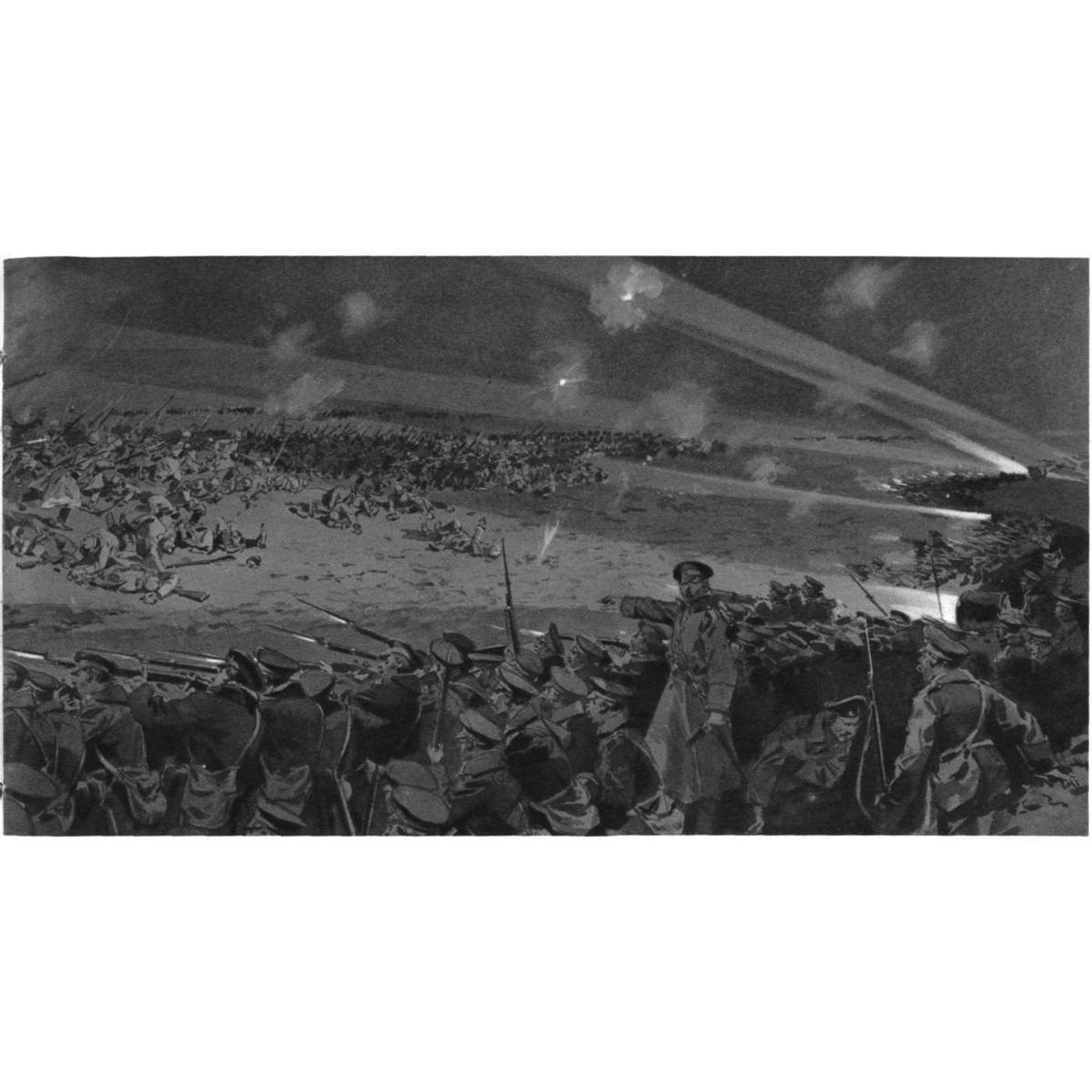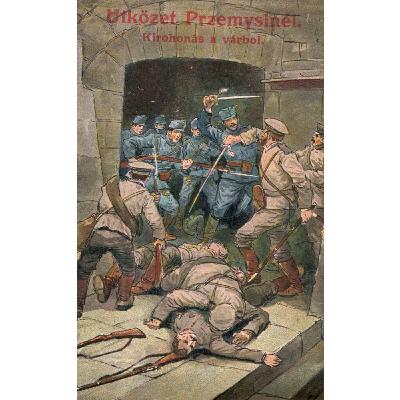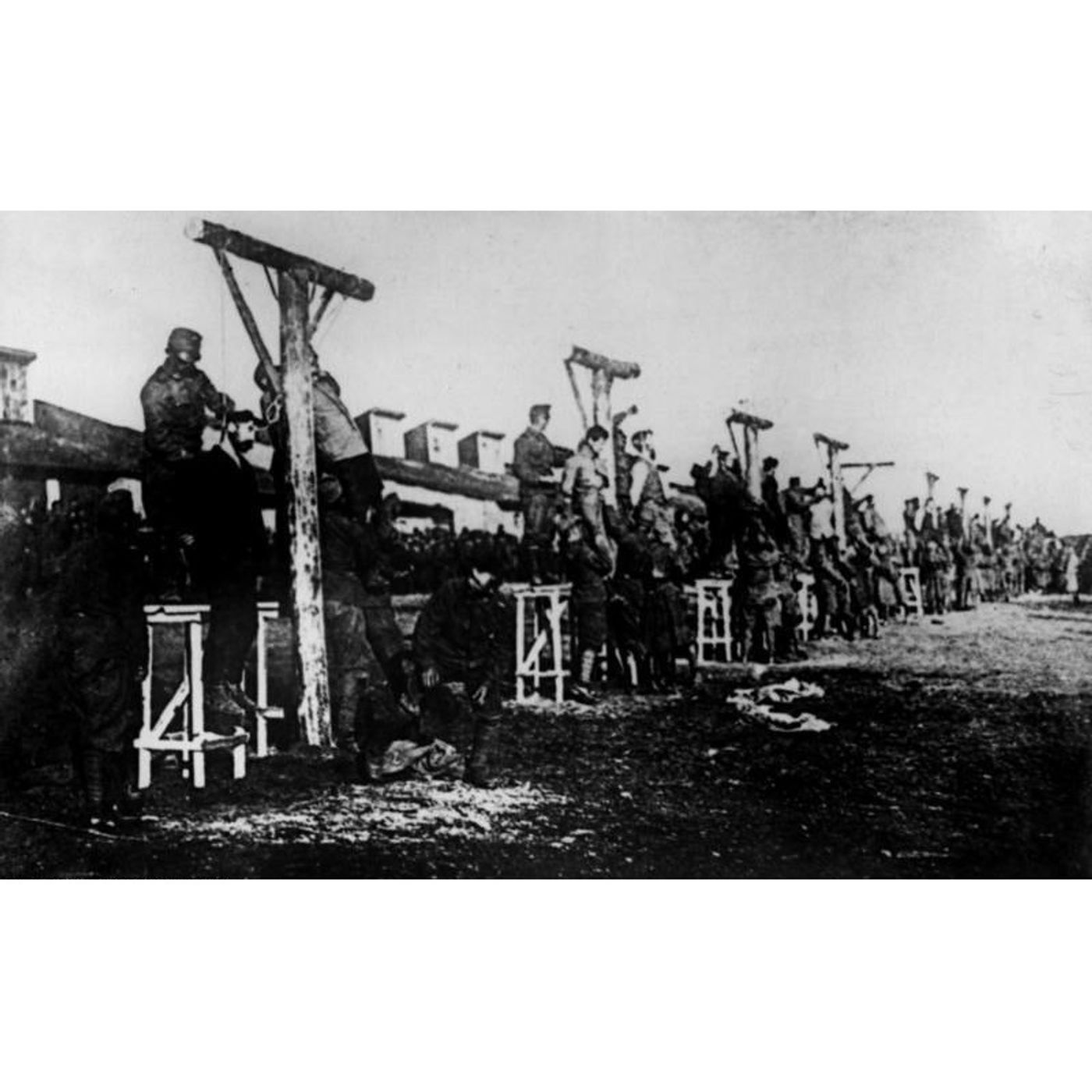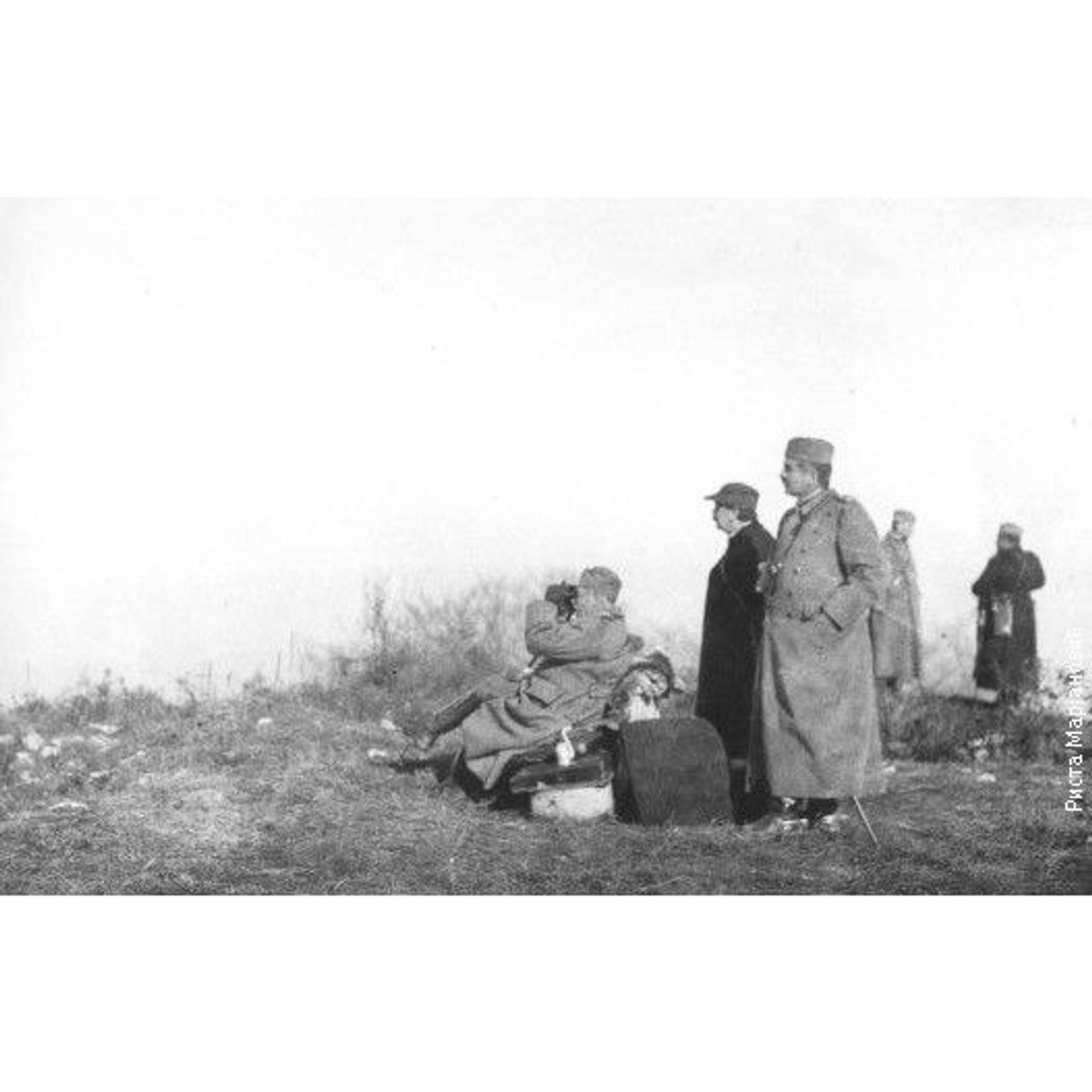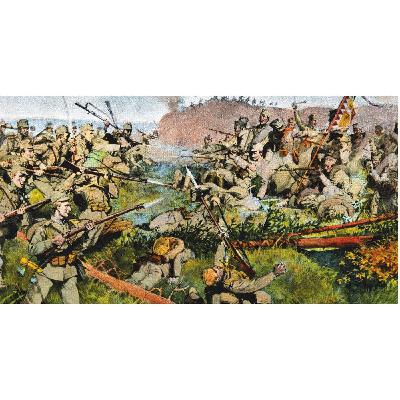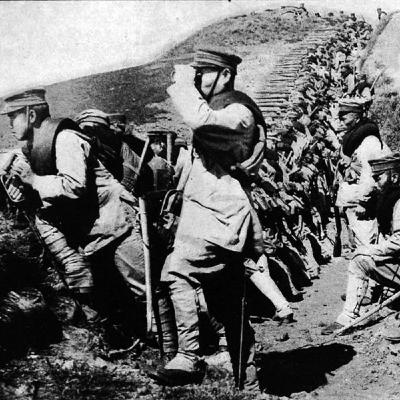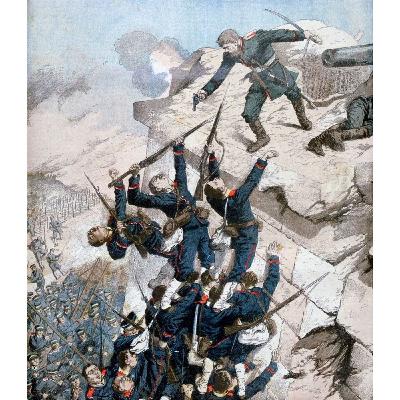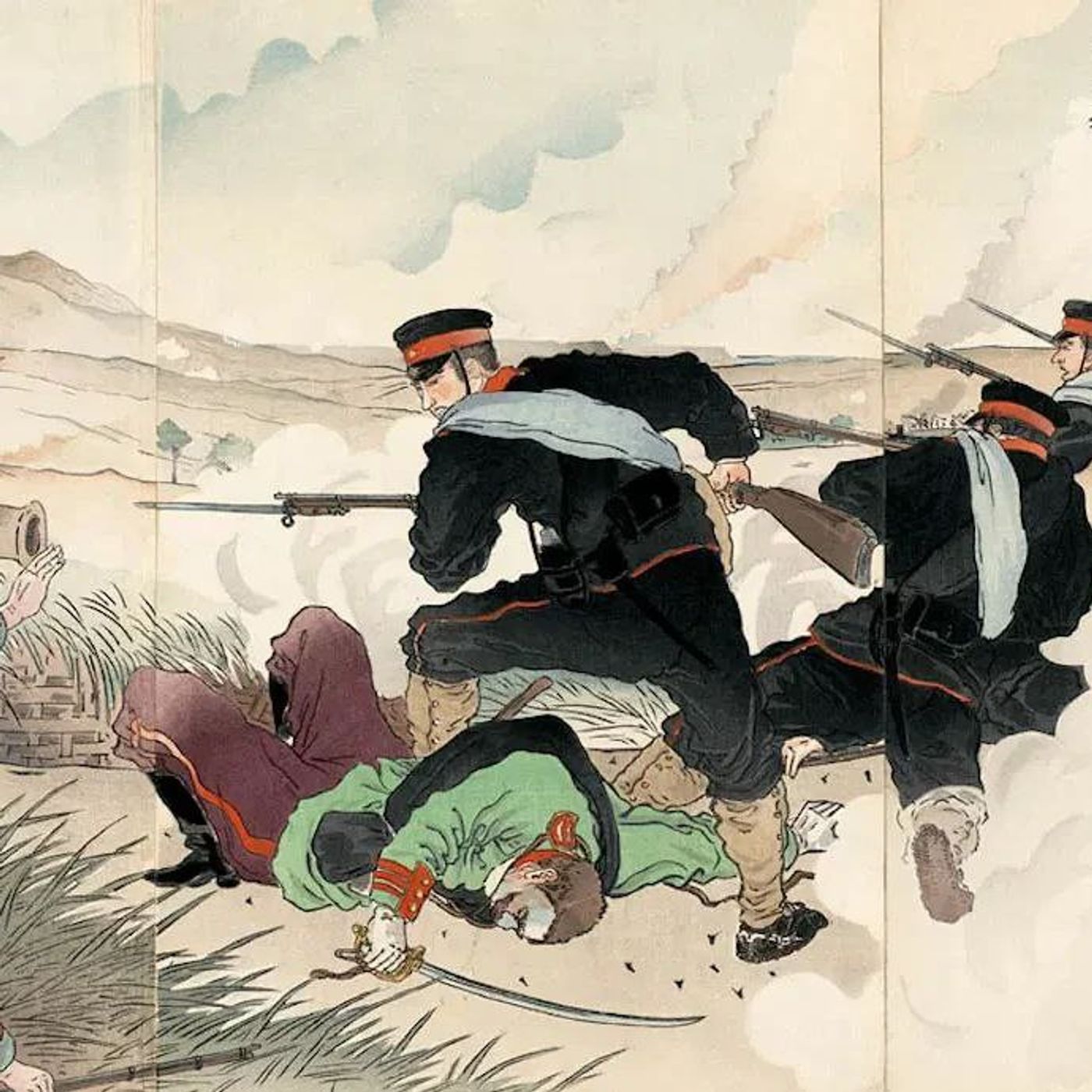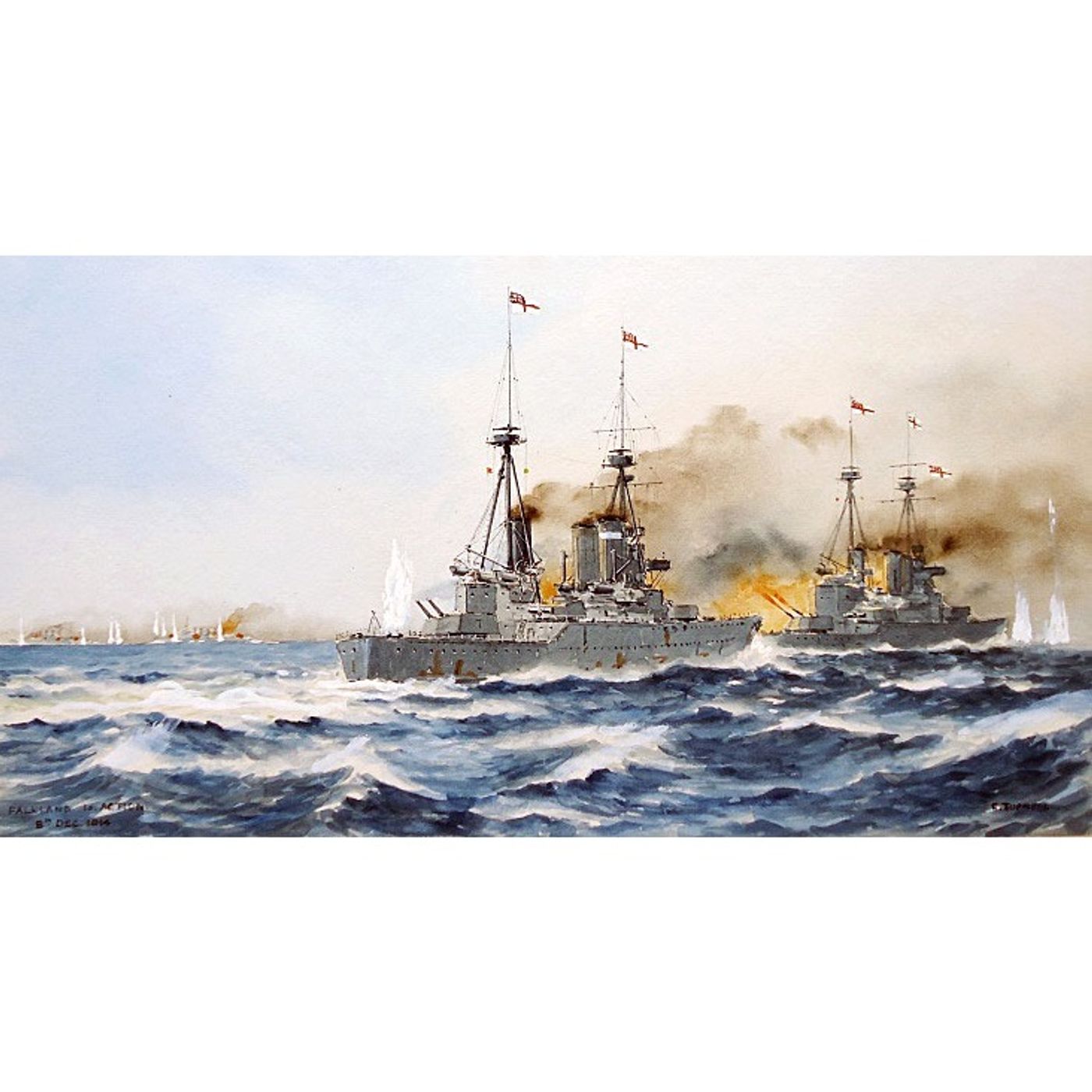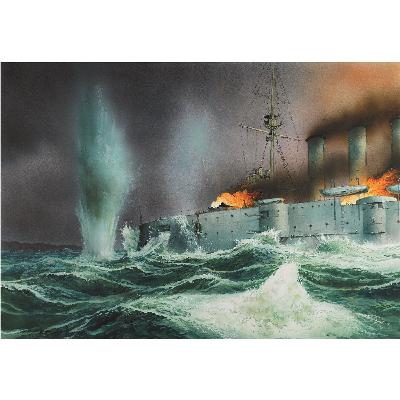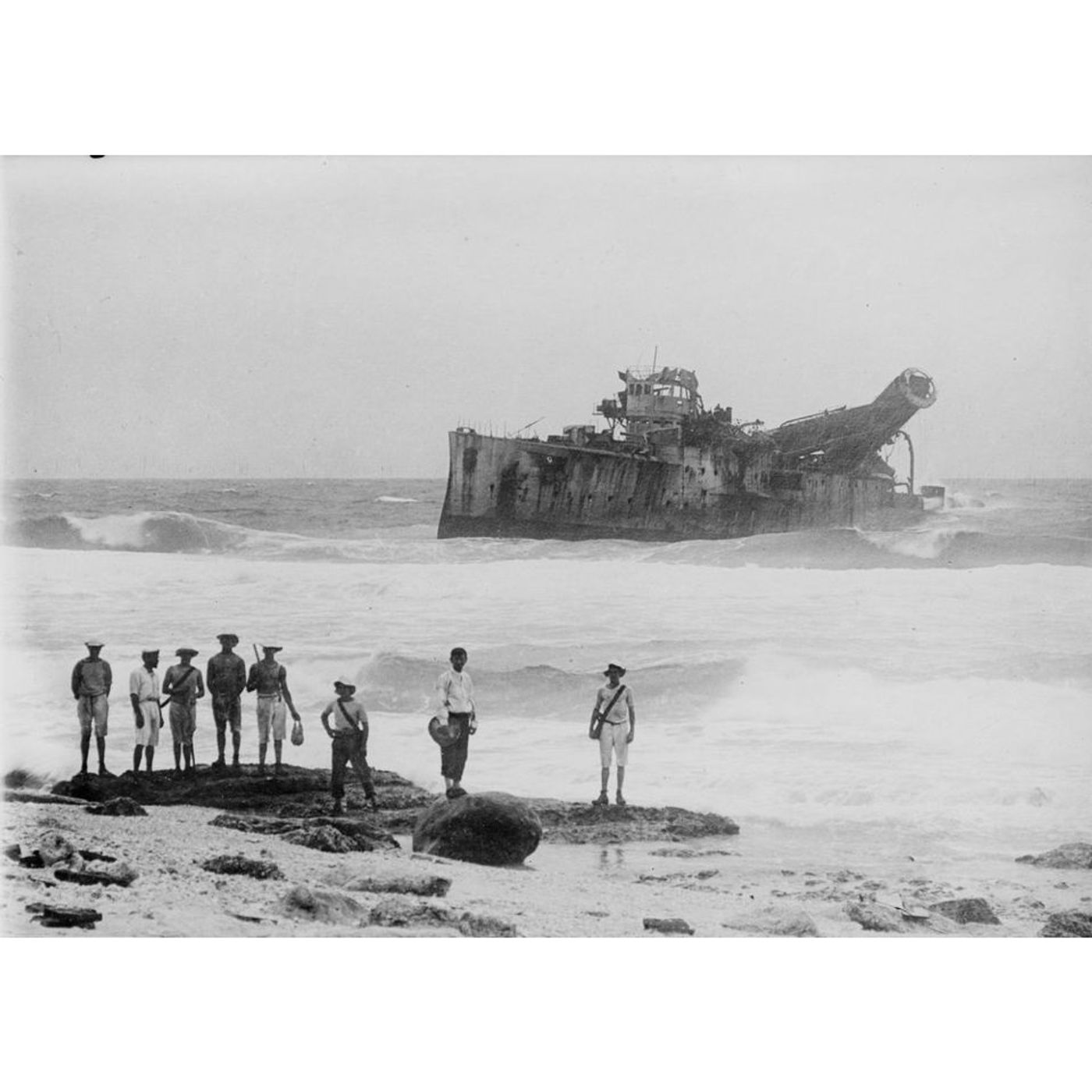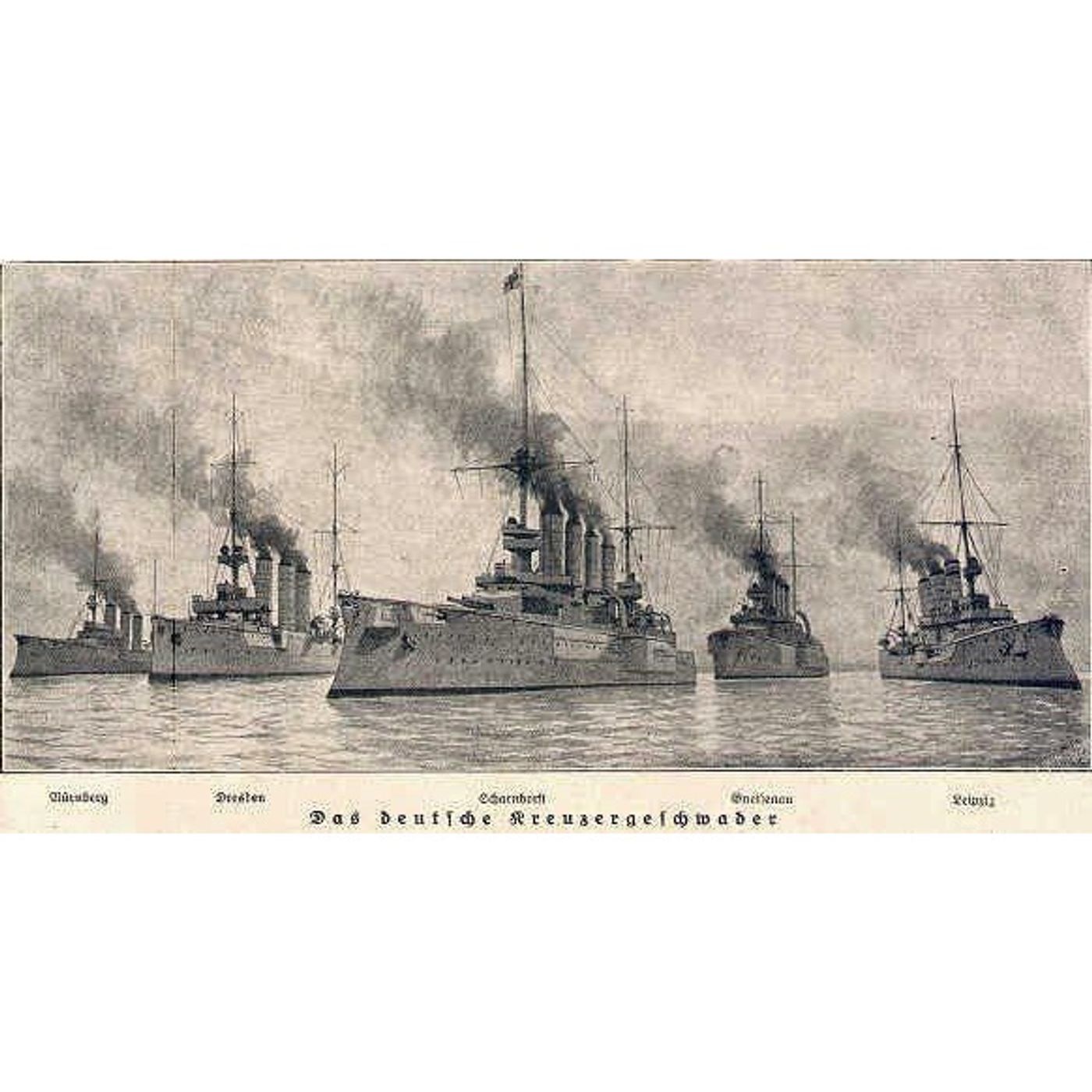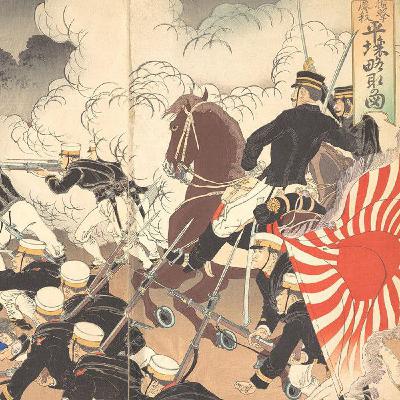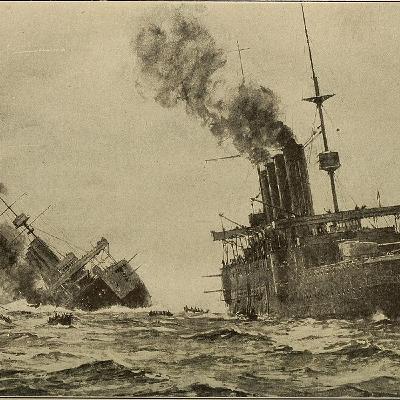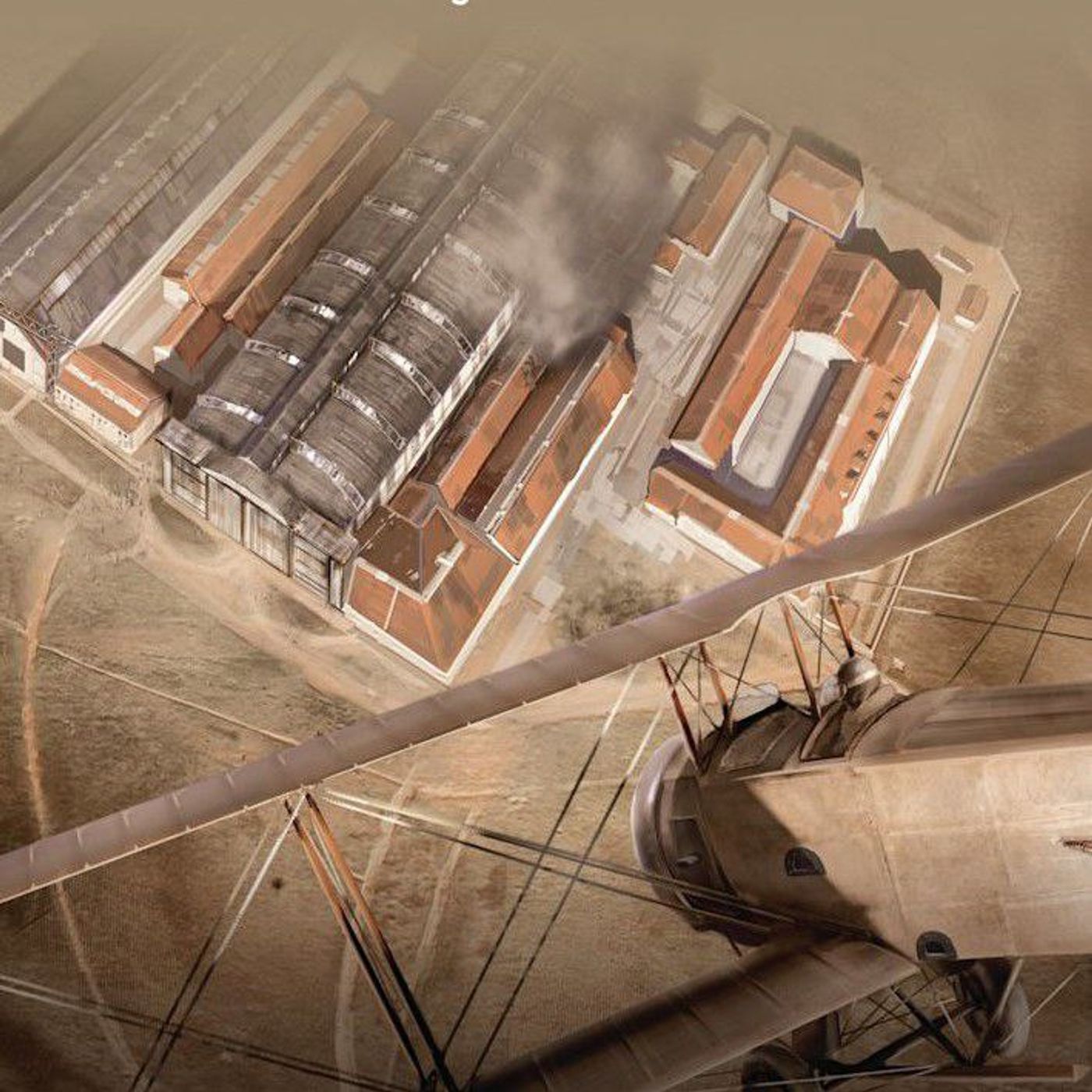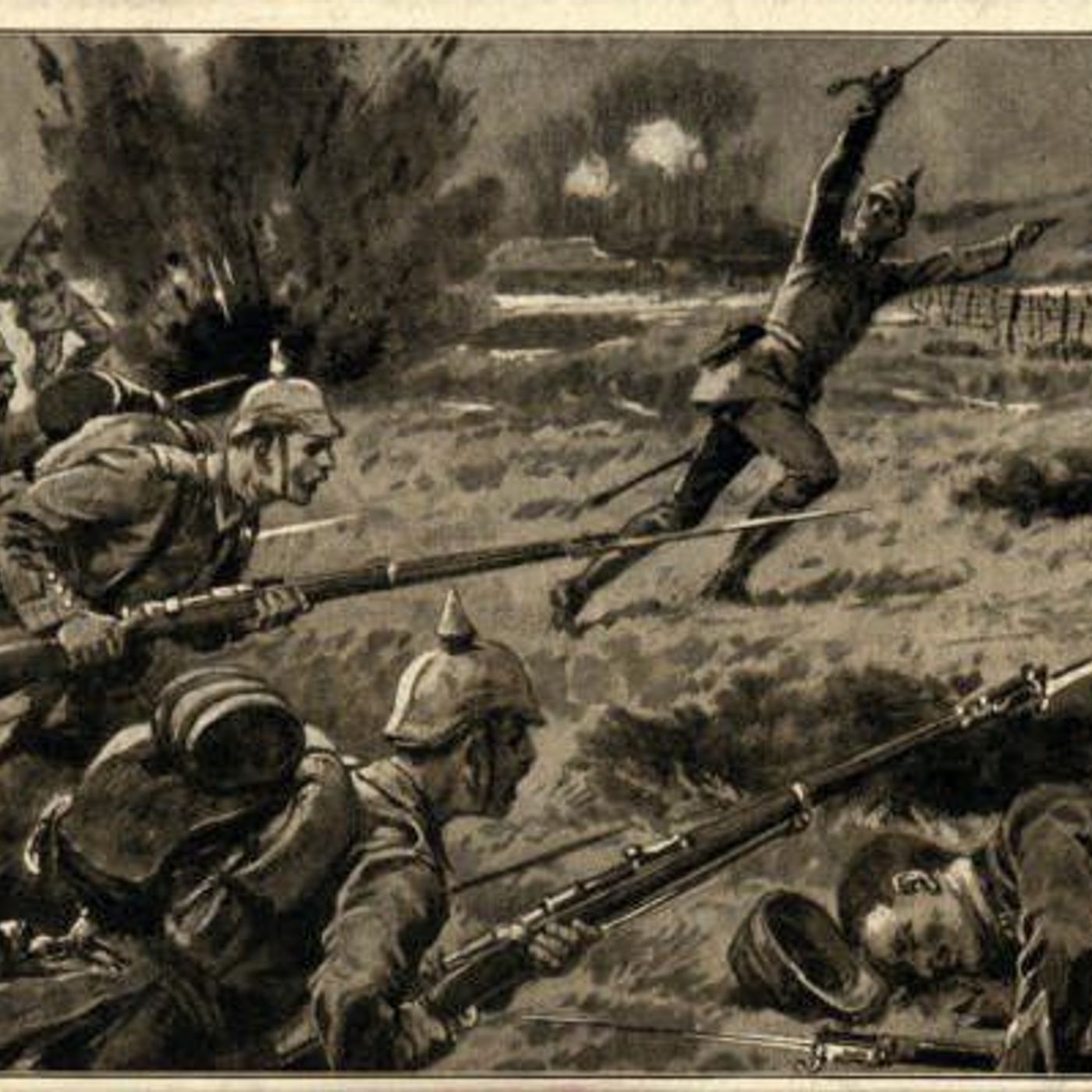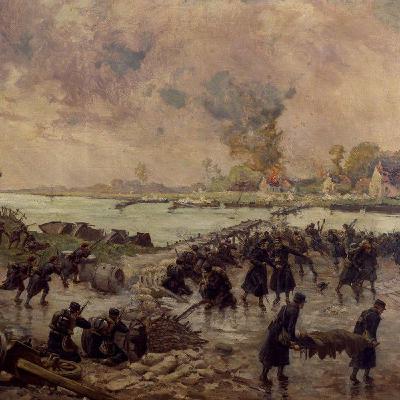Discover La Guerra Grande
La Guerra Grande

La Guerra Grande
Author: Andrea Basso
Subscribed: 73Played: 2,583Subscribe
Share
© Copyright Andrea Basso
Description
Tra il 1914 e il 1918 l'umanità assistette al conflitto più titanico della sua storia fino ad allora. Milioni di persone vennero inghiottite in un tritacarne senza precedenti, e ne uscirono cambiate per sempre, mentre altre non ne uscirono affatto.
A cura di Andrea Basso
A cura di Andrea Basso
77 Episodes
Reverse
L'Impero Ottomano comincia le sue azioni militari contro la Russia e il Regno Unito. La preparazione militare della Sublime Porta lascia però a desiderare.Seguimi su Instagram: @laguerragrande_podcastSe vuoi contribuire con una donazione sul conto PayPal: podcastlaguerragrande@gmail.comScritto e condotto da Andrea BassoMontaggio e audio: Andrea BassoFonti dell'episodio:Taner Akçam, The Young Turks' Crime against Humanity: The Armenian Genocide and Ethnic Cleansing in the Ottoman Empire, Princeton University Press, 2012Handan Nezir Akmese, The Birth of Modern Turkey: The Ottoman Military and the March to WWI, IB Tauris, 2005W. Allen, Paul Muratoff, Caucasian Battlefields, 1953Cecil Aspinall-Oglander, Military Operations Gallipoli: Inception of the Campaign to May 1915, History of the Great War Based on Official Documents by Direction of the Historical Section of the Committee of Imperial Defence, HeinemannArthur Barker, The Bastard War: The Mesopotamian Campaign of 1914-1918, Dial Press, 1967Arthur Barker, The First Iraq War—1914-1918: Britain's Mesopotamian Campaign, Enigma Books, 2013Les Carlyon, Gallipoli, Macmillan, 2001S. Cohen, The genesis of the British campaign in Mesopotamia, 1914, Middle Eastern Studies XII, 1976Early battles in Mesopotamia (Basra and Qurna, 1914), The long, long trailDavid Fromkin, A Peace to End All Peace: The Fall of the Ottoman Empire and the Creation of the Modern Middle East, Henry Holt and Company, 2010Peter Hart, La grande storia della Prima Guerra Mondiale, Newton & Compton, 2013Eugene Hinterhoff, The Campaign in Armenia, Marshall Cavendish Corporation, 1982Richard Hovannisian, The Armenian People from Ancient to Modern Times, 2004Jihad, TreccaniÜmit Kurt, A Rescuer, an Enigma and a Génocidaire: Cemal Pasha, The End of the Ottomans: The Genocide of 1915 and the Politics of Turkish Nationalism, Bloomsbury PublishingTilman Lüdke, Jihad, Holy War (Ottoman Empire), 1914-1918 Online, 2018Tigran Martirosyan, Caucasus Front, 1914-1918 Online, 2023Frederick McKenzie, The Defence of India, The Great War: The Standard History of the All-Europe ConflictRam Narain Mehra, Aden and Yemen 1905-1919, Agam Prakasham, 1988Odile Moreau, Pre-war Military Planning (Ottoman Empire), 1914-1918 Online, 2018George Morton-Jack, The Indian Army on the Western Front, Cambridge University Press, 2015David Nicolle, The Ottomans: Empire of Faith, Thalamus Publishing, 2008Garegin Pasdermadjian, Aram Torossian, Why Armenia Should be Free: Armenia's Role in the Present War, Hairenik Pub, 1918Eugene Rogan, The Fall of the Ottomans: The Great War in the Middle East, Hachette, 2015Massimo Sciarretta, Attilio Monaco (1858-1932). Un console italiano a Erzerum durante i massacri hamidiani, Rassegna Armenisti Italiani, XIII, Padus-Araxes, 2012B. Slot, Mubarak Al-Sabah: Founder of Modern Kuwait 1896–1915, Arabian Publishing Charles Townshend, Desert Hell, The British Invasion of Mesopotamia, Harvard University Press, 2011Şuhnaz Yilmaz, An Ottoman Warrior Abroad: Enver Paşa as an Expatriate, Middle Eastern Studies 35, 1999Șuhnaz Yılmaz, Revisiting Networks and Narratives: Enver Pasha's Pan-Islamic and Pan-Turkic Quest, Subversives and Mavericks in the Muslim Mediterranean: A Subaltern History, University of Texas Press, 2016Earl Wavell, The Palestine Campaigns, A Short History of the British Army, Constable & Co, 1968Erik Zürcher, Macedonians in Anatolia: The Importance of the Macedonian Roots of the Unionists for their Policies in Anatolia after 1914, Middle Eastern Studies 50, 2014Erik Zürcher, The young turk legacy and nation building, Bloomsbury Publishing, 2014In copertina: la proclamazione della jihad da parte di Haydar Efendi nella moschea Fatih di Costantinopoli, il 14 novembre del 1914. La ricolorizzazione è di Julius Backmann Jääskeläinen.
I Tedeschi tentano il tutto per tutto per difendere la Slesia dall'invasione russa. Il loro azzardo sarà ripagato. Nel frattempo, un altro contendente scende in campo a fianco degli Imperi Centrali, l'Impero Ottomano, la cui entrata nel conflitto è stata accuratamente preparata dalla Germania.Seguimi su Instagram: @laguerragrande_podcastSe vuoi contribuire con una donazione sul conto PayPal: podcastlaguerragrande@gmail.comScritto e condotto da Andrea BassoMontaggio e audio: Andrea BassoFonti dell'episodio:C. F. Aspinall-Oglander, Military Operations Gallipoli: Inception of the Campaign to May 1915, History of the Great War Based on Official Documents by Direction of the Historical Section of the Committee of Imperial Defence, Heinemann, 1929Peter Balakian, The Burning Tigris: The Armenian Genocide and America's Response, Harper & Collins, 2004Zinaida Bichanina, The First World War: Great illustrated atlas, Litres, 2018Ronald Bobroff, Roads to Glory: late imperial Russia and the Turkish Straits, IB Tauris, 2006H. Broadbent, Gallipoli: The Fatal Shore, Penguin, 2005Prit Buttar, Collision of Empires, The War on the Eastern Front in 1914, Osprey Publishing, 2016Edward Erickson, Ordered to Die: A History of the Ottoman Army in the First World War, Greenwood, 2001Caroline Finkel, Osman's Dream: The History of the Ottoman Empire, Basic Books, 2007David Fromkin, Peace to End All Peace: The Fall of the Ottoman Empire and the Creation of the Modern Middle East, Macmillan, 2010Martin Gilbert, The First World War: A Complete History, Henry Holt and Company, 1994Richard Hamilton, Holger Herwig, Decisions for War, 1914–1917, Cambridge University Press, 2005Peter Hart, La grande storia della Prima Guerra Mondiale, Newton & Compton, 2013Paul Von Hindenburg, Out of my life, Harper & Brothers, 1921Michael Howard, The First World War, Oxford University Press, 2002Glenn Jewison; Jörg C. Steiner, Higher Commands and Commanders, 2016Efraim Karsh, Inari Karsh, Empires of Sand, Harvard University Press, 1999Marian Kent, The Great Powers and the End of the Ottoman Empire, Routledge, 1996Peter Kilduff, Red Baron: The Life and Death of an Ace, Newton Abbot, 2007G. Korolkov, A strategic sketch of the War of 1914-1918, 1923Sean McMeekin, The Russian Origins of the First World War, Harvard University Press, 2011F. Menges, Liman von Sanders, Otto, Neue Deutsche Biographie 1985Geoffrey Miller, Turkey Enters the War and British Actions, 1999Sergei Nelipovich, Lodz campaign 1914, Kvadriga, 2021 Alexey Oleynikov, Russia-Shield of Entente, Piter, 2016Michael Reynolds, Shattering Empires: The Clash and Collapse of the Ottoman and Russian Empires 1908–1918, Cambridge University Press, 2011Lawrence Sondhaus, The Great War at Sea: A Naval History of the First World War, Cambridge University Press, 2014Norman Stone, The Eastern Front 1914-1917, Penguin, 1998Hew Strachan, The First World War. To Arms, Oxford University Press, 2001The New York Times Current History of the European War, 1917Ulrich Trumpener, Turkey's Entry into World War I: An Assessment of Responsibilities, Journal of Modern History 34, 1962Spencer Tucker, World War I: The Definitive Encyclopedia and Document Collection, 2014Alexander Watson, Il grande assedio di Przemysl, 1914. Storia di una battaglia dimenticata, Rizzoli, 2021In copertina: il viceammiraglio Wilhelm Souchon e il suo stato maggiore, fotografati a Costantinopoli nel gennaio del 1915.
Gli austrotedeschi compiono un'azzardata offensiva verso Varsavia, rischiando una grave sconfitta per opera dei Russi. Nella Galizia occupata, il governo zarista applica il pugno di ferro contro la popolazione ucraina ed ebraica. Il generale Conrad sceglie di sacrificare la fortezza di Przemyśl per ragioni propagandistiche e... amorose.Seguimi su Instagram: @laguerragrande_podcastSe vuoi contribuire con una donazione sul conto PayPal: podcastlaguerragrande@gmail.comScritto e condotto da Andrea BassoMontaggio e audio: Andrea BassoFonti dell'episodio:Prit Buttar, Collision of Empires, The War on the Eastern Front in 1914, Osprey Publishing, 2016 Christopher Clark, Die Schlafwandler, Deutsche Verlags-Anstalt, 2013Gina Conrad von Hötzendorf, Mein Leben mit Conrad von Hötzendorf, Grethlein, 1935Peter Hart, La grande storia della Prima Guerra Mondiale, Newton & Compton, 2013Boris Khavkin, The forgotten front. The Eastern Theater of World War I, 1914-1915, Kentucky University Press, 2018Erich Ludendorff, Meine Kriegserinnerungen 1914–1918, Harper, 1919Indy Neidell, Learning From Napoleon – Russia, The Underestimated Enemy, The Great War, 2014Sergei Nelipovich, The Russian Front of the First World War: the losses of the sides in 1914, Kvadriga, 2017Sergei Nelipovich, Warsaw-Ivangorod operation, 1914, Russian Association of Historians of the First World War, Kvadriga, 2020Alexey Oleynikov, Russia-Shield of Entente, Piter, 2016Maxim Oskin, Autumn 1914: the Battle for Poland, Veche, 2024Hans Rauscher, Manisch-depressiver Feldherr, Der Standard, 2013Gunther Rothenberg, The Army of Francis Joseph, Purdue University Press, 1976Alexander Watson, Il grande assedio di Przemysl, 1914. Storia di una battaglia dimenticata, Rizzoli, 2021Samuel Williamson, The Origins of World War I, The Massachusetts Institute of Technology and the Journal of Interdisciplinary History, 1988In copertina: da un periodico russo dell'inverno 1914, la fanteria zarista respinge un attacco notturno tedesco nelle trincee di fronte a Varsavia.
Gli uomini della Landsturm in difesa di Przemyśl sono chiamati a contare su tutto il proprio coraggio e la propria determinazione per resistere ad un violento assalto russo. Seguimi su Instagram: @laguerragrande_podcastSe vuoi contribuire con una donazione sul conto PayPal: podcastlaguerragrande@gmail.comScritto e condotto da Andrea BassoMontaggio e audio: Andrea BassoFonti dell'episodio:Prit Buttar, Collision of Empires, The War on the Eastern Front in 1914, Osprey Publishing, 2016Alexander Watson, Il grande assedio di Przemysl, 1914. Storia di una battaglia dimenticata, Rizzoli, 2021In copertina: la difesa dei forti in una illustrazione ungherese.
L'esercito austriaco che si ritira dopo la battaglia di Galizia non può più definirsi tale. La guarnigione della fortezza di Przemyśl dovrà mettere in campo tutto il proprio coraggio e tutta la propria resilienza per sbarrare la strada ai Russi.Seguimi su Instagram: @laguerragrande_podcastSe vuoi contribuire con una donazione sul conto PayPal: podcastlaguerragrande@gmail.comScritto e condotto da Andrea BassoMontaggio e audio: Andrea BassoCon la partecipazione di Zeno Du Ban, Federico Menis e Matteo RibolliFonti dell'episodio:Andrey Borisyuk, The forgotten war. Russia in 1914-1918, Veche, 2024Prit Buttar, Collision of Empires, The War on the Eastern Front in 1914, Osprey Publishing, 2016Rotem Kowner, Historical Dictionary of the Russo-Japanese War, The Scarecrow Press, 2006John Losher, The Bolsheviks: Twilight of the Romanov Dynasty, Author House, 2009Pyotr Miltatuli, Russia in the reign of Nicholas II, Rusky Isdatelski Zentr, 2017Sergei Nelipovich, Two campaigns. The Struggle for East Prussia in August-October 1914, Kvadrniga, 2023Alexey Oleynikov, Russia-Shield of Entente, Piter, 2016Hew Strachan, The First World War. To Arms, Oxford University Press, 2001Alexander Watson, Il grande assedio di Przemysl, 1914. Storia di una battaglia dimenticata, Rizzoli, 2021In copertina: soldati austroungarici impiccano dei civili ucraini, aprile 1918, dal Bundesarchiv.
Quando per il Regno di Serbia tutto sembra andare per il verso sbagliato, la situazione si ribalta completamente. Il generale Putnik, approfittando di un aiuto da parte della Francia, passa al contrattacco, guadagnando la più grande vittoria serba fino ad allora.Seguimi su Instagram: @laguerragrande_podcastSe vuoi contribuire con una donazione sul conto PayPal: podcastlaguerragrande@gmail.comScritto e condotto da Andrea BassoMontaggio e audio: Andrea BassoCon la partecipazione di Davide CampiFonti dell'episodio:Peter Hart, La grande storia della Prima Guerra Mondiale, Newton & Compton, 2013Holger Herwig, The First World War: Germany and Austria-Hungary, 1914–1918, Bloomsbury Publishing, 2014Rudolf Jeřábek: Potiorek. General im Schatten von Sarajevo, Styria, 1991David Jordan, The Balkans, Italy & Africa 1914–1918: From Sarajevo to the Piave and Lake Tanganyika, Amber Books, 2014Anton Kreuzer, Kärntner Biographische Skizzen. Kärntner Druck und Verlagsgesellschaft, 1995 Georgios Leontaritis, Nikolaos Oikonomou, Alexandros Despotopoulos, Alexandros, Greece and World War I, History of the Greek Nation, Modern Hellenism from 1913 to 1941, Ekdotiki Athinon, 1978Andrej Mitrović, Serbia's Great War, 1914–1918, Purdue University Press, 2007David Norris, Belgrade: A Cultural History, Oxford University Press, 2008Novica Pesic, Строј каплара Милунке, novosti.rs, 2007Stanovništvo Narodne Republike Srbije od 1834-1953, Belgrade: Zavod za statistiku i evidenciju Narodne Republike Srbije, 1953Dmitar Tasić, Warfare 1914-1918 (South East Europe), 1914-1918 Online, 2014Roberto Todero, Ed ogni tanto qualche palla fischiava oltre le nostre teste, Pro Loco Fogliano di Redipuglia, 2021Robert Wolfson, John Laver, Years of Change, Europe 1890-1945, Hodder Education, 1996In copertina: Pietro I, re di Serbia, assiste da un'altura alla battaglia della Kolubara.
Nonostante l'inferiorità di uomini e mezzi, il piccolo Regno di Serbia resiste a un secondo tentativo di invasione austroungarico. Tuttavia, quando la Duplice Monarchia colpisce per la terza volta, i Serbi cominciano a vacillare.Seguimi su Instagram: @laguerragrande_podcastSe vuoi contribuire con una donazione sul conto PayPal: podcastlaguerragrande@gmail.comScritto e condotto da Andrea BassoMontaggio e audio: Andrea BassoCon la partecipazione di Zeno Du BanFonti dell'episodio:Mile Bjelajac, Generali i admirali Kraljevine Jugoslavije 1918—1941, Institut za noviju istoriju Srbije, 2004Mile Bjelajac, Serbia, 1914-1918 Online, 2015M. Clodfelter, Warfare and Armed Conflicts: A Statistical Encyclopedia of Casualty and Other Figures, 1492–2015, McFarland, 2017Dennis Cove, Ian Westwell, History of World War I, Marshall Cavendish, 2002Richard C. Hall, War in the Balkans, 1914-1918 Online, 2018Peter Hart, La grande storia della Prima Guerra Mondiale, Newton & Compton, 2013David Jordan, The Balkans, Italy & Africa 1914–1918: From Sarajevo to the Piave and Lake Tanganyika, Amber Books, 2014Lepe i umne ponos roda svog, Srpsko Nasleđe – Istorijske Sveske, 1999James Lyon, Serbia and the Balkan Front, 1914: The Outbreak of the Great War, Bloomsbury Publishing, 2015Andrej Mitrović, Serbia's Great War, 1914–1918, Purdue University Press, 2007Božica Mladenović, Women's Mobilization for War (South East Europe), 1914-1918 Online, 2014Dmitar Tasić, Warfare 1914-1918 (South East Europe), 1914-1918 Online, 2014Roberto Todero, Ed ogni tanto qualche palla fischiava oltre le nostre teste, Pro Loco Fogliano di Redipuglia, 2021Spencer Tucker, World War I: Encyclopedia, 2005 Geoffrey Wawro, A Mad Catastrophe: The Outbreak of World War I and the Collapse of the Habsburg Empire, Basic Books, 2014In copertina: la battaglia per il monte Jagodnia, metà settembre 1914.
Tedeschi e Giapponesi si affrontano in una delle battaglie più particolari della Prima Guerra Mondiale, la prima ma anche l'ultima azione terrestre condotta dall'esercito imperiale nipponico nel corso del conflitto.Seguimi su Instagram: @laguerragrande_podcastSe vuoi contribuire con una donazione sul conto PayPal: podcastlaguerragrande@gmail.comScritto e condotto da Andrea BassoMontaggio e audio: Andrea BassoFonti dell'episodio:Adelaide Advertiser, 28 dicembre 1914 Asada Shinji, The siege of Qingdao, 2016 Atsushi Otsuru, Prisoners of War (Japan), 1914-1918 Online, 2014 Mike Bennighof, Far side of the world: Sterneck’s sardine tins, Avalanche Press, 2025 Annette S. Biener, Das deutsche Pachtgebiet Tsingtau in der Provinz Schantung, 1897–1914, Institutioneller Wandel durch Kolonialisierung, Studien und Quellen zur Geschichte Schantungs und Tsingtaus, Matzat, 2001 Castle Donington, Derbyshire Julian Corbett, Naval Operations to the Battle of the Falklands, History of the Great War: Based on Official Documents, Imperial War Museum, Battery Press, 1938 Colin Denis, Tsingtao Campaign, 2000 Doi Hideyuki, Prigionieri italiani in Giappone durante la Grande Guerra, Liberi 6-7-8, 2018John Fowler, “Feuerland”, a piece of Falklands' history returns to Germany, Mercopress, 2006 Rustin Gates, War Aims and War Aims Discussions (Japan), 1914-1918 Online, 2019 Idrovolante, Treccani Claudia Joseph, 'My existence is owed to a German machine gunner': Peter Jackson reveals grandfather who fought beside JRR Tolkien in WWI met his wife after being shot in one of war's first battles, Mail Online, 2018 Friedrich Kirkchner, Mit der S.M.S. Kaiserin Elisabeth in Ostasien: Das Tagebuch eines Unteroffiziers der k. u. k. Kriegsmarine (1913–1920), Boehlau, 2019 J. Manhke, Aircraft operations in the german colonies, 1911-1916, Military History Journal 12, The South African Military Society, 2001 Eberhard von Mantey, Meyer-Waldeck, Alfred, Deutsches Biographisches Jahrbuch, 1931 Sven Saaler, Qingdao, Siege of/German-Japanese War, 1914-1918 Online, 2020 Joachim Schultz-Naumann, Unter Kaisers Flagge: Deutschlands Schutzgebiete im Pazifik und in China einst und heute, Universitas, 1985 The remarkable story of Gunther Pluschow in World War Two, Essex Life, 2023 Joseph Trainor, Tsingtao 1914, 1976 Tsingtao Chinese Police, German Colonial Uniforms Spencer Tucker, The Great War 1914-1918, Routeledge, 2002 András Veperdi, The protected cruiser SMS Kaiserin Elisabeth in defence of Tsingtao in 1914, Hungarian seamen's association, 2013 H. P. Willmott, La Prima Guerra Mondiale, DK, 2006In copertina: soldati giapponesi occupano una trincea lasciata libera dai Tedeschi durante l'assedio Tsingtao, autunno 1914.
L'esercito giapponese riesce finalmente nel difficile scopo di conquistare le fortificazioni di Port Arthur. Tuttavia la guerra a terra finirà per divenire uno stallo. Lo scontro fra i due imperi verrà deciso in una delle battaglie navali più importanti della storia. Le conseguenze dell conflitto russo-giapponese avranno ripercussioni geopolitiche di lunghissimo termine.Seguimi su Instagram: @laguerragrande_podcastSe vuoi contribuire con una donazione sul conto PayPal: podcastlaguerragrande@gmail.comScritto e condotto da Andrea BassoMontaggio e audio: Andrea BassoFonti dell'episodio:Jesse Alexander, World War Zero - The Russo Japanese War 1904-1905, The Great War, 2022 Herbert Bix, Hirohito and the Making of Modern Japan, HarperCollins, 2000 Georges Blond, Admiral Togo, Jarrolds Publishers, 1961 Noel Busch, The Emperor's Sword: Japan vs Russia in the Battle of Tsushima, Funk and Wagnalls, 1969 Shannon R. Butler, Voyage to Tsuhima, Naval History 26, 2012 Franco Cardini, Sergio Valzania, La scintilla: da Tripoli a Sarajevo. Come l’Italia provocò la Prima Guerra Mondiale, Mondadori, 2014 Micheal Clodfelter, Warfare and Armed Conflicts, a statistical reference, Volume II 1900–91, McFarland, 2017 Richard Connaughton, Rising Sun and Tumbling Bear, Cassell, 2003 J. Corbett, Maritime Operations In The Russo-Japanese War 1904–1905, Naval Institute Press, 1915 Marc Ferro, Nicholas II: Last of the Tsars, Oxford University Press, 1995 Orlando Figes, A People's Tragedy: The Russian Revolution, 1891-1924, Jonathan Cape, 1996Robert Forczyk, Russian Battleship vs Japanese Battleship, Yellow Sea 1904–05, Osprey, 2009 R. Garson, Three Great Admirals – One Common Spirit?, The Naval Review 87, 1999 Andrew Gordon, Social Protest In Imperial Japan: The Hibiya Riot of 1905, Asia-Pacific Journal: Japan Focus 12, 2014 Stephen Gwynn, Spring Rice to Robert H. M. Ferguson. The Letters and Friendships of Sir Cecil Spring Rice: A Record, Houghton Mifflin, 1929 Kyung Moon Hwang, A History of Korea, Palgrave, 2010 Marius Jansen, The Making of Modern Japan, Harvard University Press, 2002 Geoffrey Jukes, The Russo-Japanese War 1904–1905. Essential Histories, Osprey Publishing, 2002 Yōko Katō, What Caused the Russo-Japanese War: Korea or Manchuria?, Social Science Japan Journal 10, 2007 Donald Keene, Emperor of Japan, Meiji and his World, 2005 Eugene Kim, Japanese Rule in Korea (1905–1910): A Case Study, Proceedings of the American Philosophical Society 106, 1962 Yoji Koda, The Russo-Japanese War: Primary Causes of Japanese Success, Naval War College Review 58, 2005 William Koenig, Epic Sea Battles, Octopus Publishing Group, 1977 Rotem Kowner, Historical Dictionary of the Russo-Japanese War, The Scarecrow Press, 2006 Thomas Lyell, Case History of Japan, 1948 Cristopher Martin, The russo-japanese war, Abelard Schuman, 1967 Francis McCullagh, With the Cossacks; Being the Story of an Irishman who Rode with the Cossacks throughout the Russo-Japanese War, Nash, 1906 Bruce Menning, Bayonets before bullets: The Imperial Russian Army, 1861–1914, Indiana University, 1992 Ian Nish, The Origins of the Russo-Japanese war, Longman, 1985 John Noss, Man's Religions, 1980 Oyama Iwao, The National Archives of Japan, National Diet Library Sarah Paine, The Sino-Japanese War of 1894–1895: Perceptions, Power, and Primacy, Cambridge University Press, 2003 Costantine Pleshakov, The Tsar's Last Armada: Epic Voyage to the Battle of Tsushima, 2002 Roger Reese, The Imperial Russian Army in Peace, War, and Revolution, 1856-1917, University Press of Kansas, 2019 Geoffrey Regan, The Battle of Tsushima 1905, The Guinness Book of Decisive Battles Guinness Publishing, 1992 Edwin Reischauer, Storia del Giappone, Bompiani, 2013 Edward Rhoads, Manchus and Han: Ethnic Relations and Political Power in Late Qing and Early Republican China, 1861–1928, University of Washington Press, 2011 Andrew Rhodes, Same Water Different Dreams: Salient Lessons of the Sino-Japanese War for Future Naval Warfare, Journal of Advanced Military Studies 11, 2020 John Röhl, Wilhelm II: Into the Abyss of War and Exile, 1900–1941, Cambridge University Press, 2014 Lawrence Sondhaus, Naval Warfare, 1815–1914, Routledge, 2001 Richard Storry, Japan and the Decline of the West in Asia, 1894–1943, St. Martins' Press, 1979 Hew Strachan, The First World War. To Arms, Oxford University Press, 2003 The San Bernardino Daily Sun, 30 May 1934 The Straits Times, 4 June 1934 Hesibo Tikowara, Before Port Arthur in a Destroyer: The Personal Diary of a Japanese Naval Officer, John Murray, 1907 Togo Heihachiro, Encyclopaedia Britannica Ko Unoki, International Relations and the Origins of the Pacific War, Springer, 2016 Vauvineux, Affairs du Corée, 1897 Denis e Peggy Warner, The Tide at Sunrise: A History of the Russo-Japanese War: 1904-1905, Charter House, 1974 Anthony Watts, The Imperial Russian Navy, Arms and Armour Press, 1990 Allen Wildman, The End of the Russian Imperial Army: The Old Army and the Soldiers' Revolt (March-April 1917), Princeton University Press, 1980In copertina: Il capitano Lebediev, in servizio presso una delle fortificazioni di Port Arthur, difende uno dei bastioni della fortezza da solo contro centinaia di soldati giapponesi che eseguono una "scala umana", dal Petit Journal del 25 settembre 1904.Ishikari Lore di Kevin MacLeod è un brano concesso in uso tramite licenza Creative Commons Attribution 4.0. https://creativecommons.org/licenses/by/4.0/Fonte: http://incompetech.com/music/royalty-free/index.html?isrc=USUAN1100192Artista: http://incompetech.com/
Dopo aver dato prova di sé nel conflitto contro la Cina, il nuovo Giappone moderno si ritrova a dover affrontare un avversario apparentemente fuori dalla sua portata: la Russia dello zar Nicola II. Il conflitto che scoppierà fra i due paesi avrà delle ripercussioni a livello mondiale.Seguimi su Instagram: @laguerragrande_podcastSe vuoi contribuire con una donazione sul conto PayPal: podcastlaguerragrande@gmail.comScritto e condotto da Andrea BassoMontaggio e audio: Andrea BassoFonti dell'episodio:Jesse Alexander, World War Zero - The Russo Japanese War 1904-1905, The Great War, 2022 Herbert Bix, Hirohito and the Making of Modern Japan, HarperCollins, 2000 Georges Blond, Admiral Togo, Jarrolds Publishers, 1961 Noel Busch, The Emperor's Sword: Japan vs Russia in the Battle of Tsushima, Funk and Wagnalls, 1969 Shannon R. Butler, Voyage to Tsuhima, Naval History 26, 2012 Franco Cardini, Sergio Valzania, La scintilla: da Tripoli a Sarajevo. Come l’Italia provocò la Prima Guerra Mondiale, Mondadori, 2014 Micheal Clodfelter, Warfare and Armed Conflicts, a statistical reference, Volume II 1900–91, McFarland, 2017 Richard Connaughton, Rising Sun and Tumbling Bear, Cassell, 2003 J. Corbett, Maritime Operations In The Russo-Japanese War 1904–1905, Naval Institute Press, 1915 Marc Ferro, Nicholas II: Last of the Tsars, Oxford University Press, 1995 Orlando Figes, A People's Tragedy: The Russian Revolution, 1891-1924, Jonathan Cape, 1996Robert Forczyk, Russian Battleship vs Japanese Battleship, Yellow Sea 1904–05, Osprey, 2009 R. Garson, Three Great Admirals – One Common Spirit?, The Naval Review 87, 1999 Andrew Gordon, Social Protest In Imperial Japan: The Hibiya Riot of 1905, Asia-Pacific Journal: Japan Focus 12, 2014 Stephen Gwynn, Spring Rice to Robert H. M. Ferguson. The Letters and Friendships of Sir Cecil Spring Rice: A Record, Houghton Mifflin, 1929 Kyung Moon Hwang, A History of Korea, Palgrave, 2010 Marius Jansen, The Making of Modern Japan, Harvard University Press, 2002 Geoffrey Jukes, The Russo-Japanese War 1904–1905. Essential Histories, Osprey Publishing, 2002 Yōko Katō, What Caused the Russo-Japanese War: Korea or Manchuria?, Social Science Japan Journal 10, 2007 Donald Keene, Emperor of Japan, Meiji and his World, 2005 Eugene Kim, Japanese Rule in Korea (1905–1910): A Case Study, Proceedings of the American Philosophical Society 106, 1962 Yoji Koda, The Russo-Japanese War: Primary Causes of Japanese Success, Naval War College Review 58, 2005 William Koenig, Epic Sea Battles, Octopus Publishing Group, 1977 Rotem Kowner, Historical Dictionary of the Russo-Japanese War, The Scarecrow Press, 2006 Thomas Lyell, Case History of Japan, 1948 Cristopher Martin, The russo-japanese war, Abelard Schuman, 1967 Francis McCullagh, With the Cossacks; Being the Story of an Irishman who Rode with the Cossacks throughout the Russo-Japanese War, Nash, 1906 Bruce Menning, Bayonets before bullets: The Imperial Russian Army, 1861–1914, Indiana University, 1992 Ian Nish, The Origins of the Russo-Japanese war, Longman, 1985 John Noss, Man's Religions, 1980 Oyama Iwao, The National Archives of Japan, National Diet Library Sarah Paine, The Sino-Japanese War of 1894–1895: Perceptions, Power, and Primacy, Cambridge University Press, 2003 Costantine Pleshakov, The Tsar's Last Armada: Epic Voyage to the Battle of Tsushima, 2002 Roger Reese, The Imperial Russian Army in Peace, War, and Revolution, 1856-1917, University Press of Kansas, 2019 Geoffrey Regan, The Battle of Tsushima 1905, The Guinness Book of Decisive Battles Guinness Publishing, 1992 Edwin Reischauer, Storia del Giappone, Bompiani, 2013 Edward Rhoads, Manchus and Han: Ethnic Relations and Political Power in Late Qing and Early Republican China, 1861–1928, University of Washington Press, 2011 Andrew Rhodes, Same Water Different Dreams: Salient Lessons of the Sino-Japanese War for Future Naval Warfare, Journal of Advanced Military Studies 11, 2020 John Röhl, Wilhelm II: Into the Abyss of War and Exile, 1900–1941, Cambridge University Press, 2014 Lawrence Sondhaus, Naval Warfare, 1815–1914, Routledge, 2001 Richard Storry, Japan and the Decline of the West in Asia, 1894–1943, St. Martins' Press, 1979 Hew Strachan, The First World War. To Arms, Oxford University Press, 2003 The San Bernardino Daily Sun, 30 May 1934 The Straits Times, 4 June 1934 Hesibo Tikowara, Before Port Arthur in a Destroyer: The Personal Diary of a Japanese Naval Officer, John Murray, 1907 Togo Heihachiro, Encyclopaedia Britannica Ko Unoki, International Relations and the Origins of the Pacific War, Springer, 2016 Vauvineux, Affairs du Corée, 1897 Denis e Peggy Warner, The Tide at Sunrise: A History of the Russo-Japanese War: 1904-1905, Charter House, 1974 Anthony Watts, The Imperial Russian Navy, Arms and Armour Press, 1990 Allen Wildman, The End of the Russian Imperial Army: The Old Army and the Soldiers' Revolt (March-April 1917), Princeton University Press, 1980In copertina: Battaglia del fiume Sha, Yoshikuni, 1904Ishikari Lore di Kevin MacLeod è un brano concesso in uso tramite licenza Creative Commons Attribution 4.0. https://creativecommons.org/licenses/by/4.0/Fonte: http://incompetech.com/music/royalty-free/index.html?isrc=USUAN1100192Artista: http://incompetech.com/
L'odissea dello Squadrone Tedesco dell'Asia Orientale giunge alla sua tragica fine al largo delle isole Falkland, dopo quattro mesi di navigazione, dai mari della Cina fino all'Atlantico meridionale, dopo 44.600 miglia nautiche percorse in acque ostili. Le perdite umane saranno terribili.Seguimi su Instagram: @laguerragrande_podcastSe vuoi contribuire con una donazione sul conto PayPal: podcastlaguerragrande@gmail.comScritto e condotto da Andrea BassoMontaggio e audio: Andrea BassoFonti dell'episodio:Teresa Arijón, Alemanes del Volga. Dejaron Rusia y en Entre Ríos fundaron varias aldeas donde celebran sus tradiciones, La Nacion, 2021 Cristopher Bell, Churchill and the Dardanelles, Oxford University Press, 2017 Geoffrey Bennett, Naval Battles of the First World War, Pen & Sword Military Classics, 2005 R. A. Burt, British Battleships 1889–1904, Seaforth Publishing, 1988 J. Corbett, Naval Operations. History of the Great War based on Official Documents, Imperial War Museum, 2009 Jason Daley, German Ship Sunk During WWI Found Off Falkland Islands, The Smithsonian, 2019 Victoria Dannemann, Alemanes en Chile: entre el pasado colono y el presente empresarial, Deutsche Welle, 2011 Aidan Dodson, The Kaiser's Battlefleet: German Capital Ships 1871–1918, Seaforth Publishing, 2016 H. Glenn Penny, Material Connections: German Schools, Things, and Soft Power in Argentina and Chile from the 1880s through the Interwar Period, Comparative Studies in Society and History 59, 2017 Erich Gröner, German Warships 1815–1945, Naval Institute Press, 1990 Paul Halpern, Cradock, Sir Christopher George Francis Maurice (1862–1914), Oxford Dictionary of National Biography, Oxford University Press, 2004 Peter Hart, La grande storia della Prima Guerra Mondiale, Newton & Compton, 2013 Hans Hildebrand, Albert Röhr, Hans-Otto Steinmetz, Die Deutschen Kriegsschiffe: Biographien – ein Spiegel der Marinegeschichte von 1815 bis zur Gegenwart, Mundus Verlag, 1993 David Howarth, Le corazzate, Mondadori, 1988 Richard Hough, Falklands 1914: The Pursuit of Admiral Von Spee, Periscope Publishing, 1980 Stewart Jackson, The First Casualties in the Royal Canadian Navy, 2001 Hermann Kirchhoff, Maximilian, graf von Spee, der Sieger von Coronel: Das Lebensbild und die Erinnerungen eines deutsches Seemanns, Marinedank-Verlag, 1915 Nicholas Lambert, Planning Armageddon: British Economic Warfare and the First World War, Harvard University Press, 2012 Robert Massie, Castles of Steel: Britain, Germany, and the Winning of the Great War at Sea, Random House, 2003 Os Alemães no Sul do Brasil, Editora Ulbra, 2004 Daniele Pompejano, Storia dell’America Latina, Mondadori, 2012 Franz von Rintelen, The Dark Invader: Wartime Reminiscences of a German Naval Intelligence Officer, Routledge, 1998 Soft Power, Treccani Gary Staff, Battle on the Seven Seas, Pen & Sword Maritime, 2011 Hew Strachan, The First World War: To Arms, Oxford University Press, 2001 Gordon Williamson, German Pocket Battleships 1939–1945, Osprey Publishing, 2003In copertina: HMS Invincible e HMS Inflexible aprono il fuoco sull'Ostasiengeschwader all'inizio della battaglia delle isole Falkland, 8 dicembre 1914. Illustrazione di Eric Tuffnell.
La navigazione dello squadrone di Von Spee verso le coste del Sudamerica prosegue. Al largo delle coste cilene, i Tedeschi affrontano e sconfiggono uno squadrone britannico, per poi penetrare nell'Atlantico. Il viceammiraglio Von Spee sa bene però che le sue navi hanno le ore contate.Seguimi su Instagram: @laguerragrande_podcastSe vuoi contribuire con una donazione sul conto PayPal: podcastlaguerragrande@gmail.comScritto e condotto da Andrea BassoMontaggio e audio: Andrea BassoFonti dell'episodio:Teresa Arijón, Alemanes del Volga. Dejaron Rusia y en Entre Ríos fundaron varias aldeas donde celebran sus tradiciones, La Nacion, 2021 Cristopher Bell, Churchill and the Dardanelles, Oxford University Press, 2017 Geoffrey Bennett, Naval Battles of the First World War, Pen & Sword Military Classics, 2005 R. A. Burt, British Battleships 1889–1904, Seaforth Publishing, 1988 J. Corbett, Naval Operations. History of the Great War based on Official Documents, Imperial War Museum, 2009 Jason Daley, German Ship Sunk During WWI Found Off Falkland Islands, The Smithsonian, 2019 Victoria Dannemann, Alemanes en Chile: entre el pasado colono y el presente empresarial, Deutsche Welle, 2011 Aidan Dodson, The Kaiser's Battlefleet: German Capital Ships 1871–1918, Seaforth Publishing, 2016 H. Glenn Penny, Material Connections: German Schools, Things, and Soft Power in Argentina and Chile from the 1880s through the Interwar Period, Comparative Studies in Society and History 59, 2017 Erich Gröner, German Warships 1815–1945, Naval Institute Press, 1990 Paul Halpern, Cradock, Sir Christopher George Francis Maurice (1862–1914), Oxford Dictionary of National Biography, Oxford University Press, 2004 Peter Hart, La grande storia della Prima Guerra Mondiale, Newton & Compton, 2013 Hans Hildebrand, Albert Röhr, Hans-Otto Steinmetz, Die Deutschen Kriegsschiffe: Biographien – ein Spiegel der Marinegeschichte von 1815 bis zur Gegenwart, Mundus Verlag, 1993 David Howarth, Le corazzate, Mondadori, 1988 Richard Hough, Falklands 1914: The Pursuit of Admiral Von Spee, Periscope Publishing, 1980 Stewart Jackson, The First Casualties in the Royal Canadian Navy, 2001 Hermann Kirchhoff, Maximilian, graf von Spee, der Sieger von Coronel: Das Lebensbild und die Erinnerungen eines deutsches Seemanns, Marinedank-Verlag, 1915 Nicholas Lambert, Planning Armageddon: British Economic Warfare and the First World War, Harvard University Press, 2012 Robert Massie, Castles of Steel: Britain, Germany, and the Winning of the Great War at Sea, Random House, 2003 Os Alemães no Sul do Brasil, Editora Ulbra, 2004 Daniele Pompejano, Storia dell’America Latina, Mondadori, 2012 Franz von Rintelen, The Dark Invader: Wartime Reminiscences of a German Naval Intelligence Officer, Routledge, 1998 Soft Power, Treccani Gary Staff, Battle on the Seven Seas, Pen & Sword Maritime, 2011 Hew Strachan, The First World War: To Arms, Oxford University Press, 2001 Gordon Williamson, German Pocket Battleships 1939–1945, Osprey Publishing, 2003In copertina: Il Good Hope o il Monmouth in fiamme sotto il fuoco tedesco durante la battaglia di Coronel, 1 novembre 1914. Peter Dennis, Osprey Publishing.
Karl von Müller, capitano dell'incrociatore leggero SMS Emden, si porta nell'Oceano Indiano per portare avanti una solitaria guerra di corsa contro i traffici mercantili alleati. I risultati che ottiene rendono lui e la sua nave una vera celebrità in Germania, e uno spauracchio nel Regno Unito.Seguimi su Instagram: @laguerragrande_podcastSe vuoi contribuire con una donazione sul conto PayPal: podcastlaguerragrande@gmail.comScritto e condotto da Andrea BassoMontaggio e audio: Andrea BassoFonti dell'episodio:Australian War MemorialMike Carlton, First Victory: 1914. Australia, Heinemann, 2013Vic Cassells, The Capital Ships: Their Battles and their Badges, Simon & Schuster, 2000Cocos, TreccaniJ. Corbett, Naval Operations. History of the Great War based on Official Documents, Imperial War Museum, 2009Todd Crowell, Bloody Dawn in Penang, Naval History, U. S. Naval Institute, 2013Denis Fairfax, John Collings Glossop (1871–1934), Australian Dictionary of Biography, 1983Friedrich Forstmeier, SMS Emden, Small Protected Cruiser 1906—1914, Warship Profile 25, Profile Publications, 1972Tom Frame, No Pleasure Cruise: The Story of the Royal Australian Navy, Allen & Unwin, 2004Erich Gröner, German Warships 1815–1945, Naval Institute Press, 1990Paul Halpern, Naval History of World War I, U. C. L. P., 1994Hans Hildebrand, Albert Röhr, Hans-Otto Steinmetz, Die Deutschen Kriegsschiffe: Biographien – ein Spiegel der Marinegeschichte von 1815 bis zur Gegenwart, Mundus Verlag, 1993David Howarth, Le corazzate, Mondadori, 1988Arthur Jose, The Royal Australian Navy, 1914–1918. Official History of Australia in the War of 1914–1918, Angus & Robertson, 1941John Keegan, Intelligence in War, Vintage Books, 2004V.V. Khromov, Kreysera tipa "Zhemchug", Morskaya Kollekcya, 2005Gerhard Koop, Klaus-Peter Schmolke, German light cruisers of World War II: Emden, Königsberg, Karlsruhe, Köln, Leipzig, Nürnberg, Naval Institute Press, 2002V. Lobichin, I. Stoljarov, I. Aladin, Еще раз о гибели крейсера «Жемчуг», Istoricheski Rosvik, 1996R. K. Lochner, The Last Gentleman of War. The Raider Exploits of the Cruiser Emden, Naval Institute Press, 1988Francis March, History of the World War, U. P. U. S. C., 1919 Hans Mehl, Naval Guns: 500 Years of Ship and Coastal Artillery, Naval Institute Press, 2002Narrative of the Proceedings of H.M.A.S. Sydney, Naval Review, 1915Ajay Saini, How German cruiser ‘Emden’ struck terror in the heart of the British Empire, and became a Tamil word, The Hindu, 2020Gary Staff, Battle on the Seven Seas, Pen & Sword Maritime, 2011The Emden at Panang, The New York Times, 1914The War at Sea, The Independent, 9 November 1914Tragedy in Penang, 2017Dan Van der Vat, Gentlemen of War, The Amazing Story of Captain Karl von Müller and the SMS Emden, William Morrow and Company, 1984Keith Yates, Graf Spee's Raiders: Challenge to the Royal Navy, 1914–1915, Naval Institute Press, 1995In copertina: gruppo di marinai (o di nativi?) in posa di fronte al relitto dell'Emden arenato alle isole Cocos, anni '20 o '30, foto di Allan Green.
Una delle più minacciose formazioni navali della Germania si ritrova isolata nel mezzo dell'Oceano Pacifico. Circondata da ogni lato da territori nemici, il suo abile comandante, sceglie di provare ad attraversare da parte a parte il più grande oceano del mondo, per colpire i traffici alleati e cercare di raggiungere la madrepatria.Seguimi su Instagram: @laguerragrande_podcastSe vuoi contribuire con una donazione sul conto PayPal: podcastlaguerragrande@gmail.comScritto e condotto da Andrea BassoMontaggio e audio: Andrea BassoFonti dell'episodio:Geoffrey Bennett, Naval Battles of the First World War, Pen & Sword Military Classics, 2005Jamie Bisher, The Intelligence War in Latin America, 1914–1922, McFarland & Company, 2016Bombardment of Papeete, American Forestry, University of Harvard, 1915Copra, TreccaniJ. Corbett, Naval Operations. History of the Great War based on Official Documents, Imperial War Museum, 2009Noëlle Destremau, Michel Gasse, La défense de Tahiti – Septembre 1914, 1999Evening Star, 07/04/1917Ernest Fayle, Seaborne Trade, History of the Great War Based on Official Documents by Direction of the Historical Section of the Committee of Imperial Defence, 1920Friedrich Forstmeier, SMS Emden, Small Protected Cruiser 1906—1914, Warship Profile 25, Profile Publications, 1972J. Gray, Amerika Samoa: A History of American Samoa and its United States Naval Administration, United States Naval Institute, 1960Erich Gröner, German Warships 1815–1945, Naval Institute Press, 1990Bruce Gudmundsson, On Armor, Praeger Publishers, 2004Paul Halpern, Naval History of World War I, U. C. L. P., 1994Hans Hildebrand, Albert Röhr, Hans-Otto Steinmetz, Die Deutschen Kriegsschiffe: Biographien – ein Spiegel der Marinegeschichte von 1815 bis zur Gegenwart, Mundus Verlag, 1993Richard Hough, Falklands 1914: The Pursuit of Admiral Von Spee, Periscope Publishing, 1980 Arthur Jose, The Royal Australian Navy, 1914–1918. Official History of Australia in the War of 1914–1918, Angus & Robertson, 1941Ian McGibbon, The Shaping of New Zealand's War Effort, August–October 1914, New Zealand's Great War: New Zealand, the Allies & the First World War, Exisle Publishing, 2007Robert Robinson, Electronic Warfare in WW1Stephen Smith, The Samoa (N.Z.) Expeditionary Force 1914–1915, Ferguson & Osborn, 1924Lawrence Sondhaus, The Great War at Sea: A Naval History of the First World War, Cambridge University Press, 2014Hew Strachan, The First World War: To Arms, Oxford University Press, 2001Gary Staff, Battle on the Seven Seas, Pen & Sword Maritime, 2011 Sydney Morning Herald, 22 October 1914J. B. Taltavall, How the Fanning Island Cable Station Was Captured and Destroyed by the Germans, Telegraph and Telephone Age, 1914Dan Van der Vat, Gentlemen of War, The Amazing Story of Captain Karl von Müller and the SMS Emden, William Morrow and Company, 1984In copertina: cartolina celebrativa delle navi dello Squadrone Tedesco dell'Asia Orientale. Da sinistra a destra: incrociatore leggero SMS Nürnberg, incrociatore leggero Dresden, incrociatore corazzato Scharnhorst, incrociatore corazzato Gneisenau, incrociatore leggero Leipzig.
In questo secondo episodio speciale, vedremo come l'Impero nipponico, per la prima volta dopo la modernizzazione, abbia gettato uno sguardo oltre i propri confini. Per ottenere il predominio in Asia Orientale ed essere trattato alla pari dalle potenze occidentali, il Giappone dovrà confrontarsi militarmente con la Cina.Seguimi su Instagram: @laguerragrande_podcastSe vuoi contribuire con una donazione sul conto PayPal: podcastlaguerragrande@gmail.comScritto e condotto da Andrea BassoMontaggio e audio: Andrea BassoFonti dell'episodio:Michael R. Auslin, Toshihiko Kishi, Hanae Kurihara Kramer, Scott Kramer, Barak Kushner, Olivia Morello, Kaoru (Kay) Ueda, Fanning the Flames: Propaganda in Modern Japan, 2021 Rosa Caroli, Francesco Gatti, Storia del Giappone, Laterza, 2007 Chonin, Encyclopaedia Britannica L. M. Cullen, A History of Japan, 1582–1941: Internal and External Worlds, Cambridge University Press, 2003 Giuliano Da Frè, Storia delle battaglie sul mare, Odoya, 2014 John W. Dower, War Without Mercy: Race and Power in the Pacific War, Pantheon, 1986 Peter Duus, Modern Japan, Houghton Mifflin, 1998 Peter Duus, The Abacus and the Sword: The Japanese Penetration of Korea, University of California Press, 1998 Bruce Elleman, Modern Chinese Warfare, 1795–1989, Routledge, 2001 Gabriele Esposito, Japanese Armies 1868–1877: The Boshin War and Satsuma Rebellion, Osprey Publishing, 2020 David Evans, Mark Peattie, Kaigun: strategy, tactics, and technology in the Imperial Japanese Navy, 1887–1941, Naval Institute Press, 1997 Allen Fung, Testing the Self-Strengthening: The Chinese Army in the Sino-Japanese War of 1894–1895, Modern Asian Studies 30, 1996 Hane Mikiso, Modern Japan: A Historical Survey Sue Henny, Jean-Pierre Lehmann, Themes and Theories in Modern Japanese History: Essays in Memory of Richard Storry, A&C Black, 2013 James Huffman, Modern Japan: An Encyclopedia of History, Culture, and Nationalism, Garland Reference Library of the Humanities, Routledge, 1997 Marius Jansen, The Making of Modern Japan, Harvard University Press, 2002 Kim Jinwung, A History of Korea: From "Land of the Morning Calm" to States in Conflict, Indiana University Press, 2012 Philip Jowett, China's Wars: Rousing the Dragon 1894–1949, Bloomsbury Publishing, 2013 Donald Keene, Emperor of Japan: Meiji and His World, 1852-1912, Columbia University Press, 2002 Liu Kwang-Ching, The Cambridge History of China, Late Ch'ing, 1800–1911, Cambridge University Press, 1978 James McClain, Japan, a modern history, Norton, 2001 Naotaka Hirota, Steam Locomotives of Japan, Kodansha International Ltd, 1972 Piotr Olender, Sino-Japanese Naval War 1894–1895, MMPBooks, 2014 Christopher Paik, Abbey Steele, Seiki Tanaka, Constraining the Samurai: Rebellion and Taxation in Early Modern Japan, International Studies Quarterly 61, 2017 Sarah Paine, The Sino-Japanese War of 1894–1895: Perceptions, Power, and Primacy. Cambridge University Press, 2003 Pebrina, Treccani Christian Polak, Silk and Light: 100-year history of unconscious French-Japanese cultural exchange (Edo Period – 1950), Hachette, 2001 Richard Ponsonby-Fane, Kyoto: the Old Capital of Japan, 794–1869, 1956 Mark Ravina, To Stand with the Nations of the World: Japan's Meiji Restoration in World History, Oxford University Press, 2017 Edwin Reischauer, Storia del Giappone, Bompiani, 2013 Chris Rowthorn, Giappone, EDT, 2008 Michael Seth, A History of Korea: From Antiquity to the Present, Rowman & Littlefield Publishers, 2010 John Sewall, The Logbook of the Captain's Clerk: Adventures in the China Seas, Chas H. Glass & Co., 1905 Lawrence Sondhaus, Naval Warfare, 1815–1914, Routledge, 2001 Henry Van Straelen, Yoshida Shoin Forerunner Of The Meiji Restoration, Brill, 1952 Conrad D. Totman, Japan before Perry: a short history, University of California Press, 1981 Trudy Ring, Robert M. Salkin, Paul E. Schellinger, Sharon La Boda, Noelle Watson, Christopher Hudson, Adele Hast, International Dictionary of Historic Places: Asia and Oceania, Taylor & Francis, 1994 Jacopo Turco, Come ha fatto il Giappone a diventare così ricco?, Nova Lectio, 2024 Howard Van Zandt, Pioneer American Merchants in Japan, Tuttle Publishing, 1984 Arthur Walworth, Black Ships Off Japan: The Story of Commodore Perry's Expedition, Read Books, 2008In copertina: Nessun nemico resiste dove noi ci rechiamo: la resa di Pyongyang, stampa di Migita Toshihide, 1894, Metropolitan Museum of ArtIshikari Lore di Kevin MacLeod è un brano concesso in uso tramite licenza Creative Commons Attribution 4.0. https://creativecommons.org/licenses/by/4.0/Fonte: http://incompetech.com/music/royalty-free/index.html?isrc=USUAN1100192Artista: http://incompetech.com/
La guerra sui mari si sviluppa nell'Adriatico, fra l'Austria-Ungheria, la Francia e il Montenegro, ma anche nel Mare del Nord, dove gli Uboot della Kaiserliche Marine ottengono la loro consacrazione definitiva. Il sommergibile diviene l'arma definitiva della Germania per la prosecuzione della propria guerra navale.Seguimi su Instagram: @laguerragrande_podcastSe vuoi contribuire con una donazione sul conto PayPal: podcastlaguerragrande@gmail.comScritto e condotto da Andrea BassoMontaggio e audio: Andrea BassoFonti dell'episodio:Annuaire de la Marine, 1915Günter Bischof, Ferdinand Karlhofer, Nicole-Melanie Goll, Samuel R. Williamson, ‘Our Weddigen.’ On the Construction of the War Hero in the k.u.k. Army.: The ‘Naval Hero’ Egon Lerch as an Example, 1914: Austria-Hungary, the Origins, and the First Year of World War I, Univertity of New Orleans Press, 2014Douglas Botting, I sommergibili, Mondadori, 1988 Heiko Brendel, Lovćen, 1914-1918 Online, 2014British Merchant Ships Lost to Enemy Action, Years 1914, 1915, 1916 in date order, Naval History, 2011David Brown, The Grand Fleet: Warship Design and Development 1906–1922, U. S. Naval Institute, 1999Malcolm Brown, The Imperial War Museum Book of the First World War: A Great Conflict Recalled in Previously Unpublished Letters, Diaries, Documents and Memoirs, University of Oklahoma Press, 1993Marc Castel, Fresnel, Sous marins francais Richard Compton-Hall, Submarines at war, 1914–18, Periscope Publishing, 2004J. S. Corbett, Naval Operations. History of the Great War based on Official Documents, Imperial War Museum and Naval & Military Press, 1938Károly Csonkaréti, Marynarka Wojenna Austro-Węgier w I wojnie światowej 1914-1918, Arkadiusz Wingert, 2004Mike Farquharson-Roberts, A History of the Royal Navy: World War I, I.B.Tauris, 2014Robert Gardiner, Randal Gray, Conway's All The World's Fighting Ships 1906–1921, Conway Maritime Press, 1985R. Gibson, M. Prendergast, The German Submarine War, 1914–1918, Naval Institute Press, 2003James Goldrick, Before Jutland: The Naval War in Northern European Waters, August 1914 – February 1915, U. S. Naval Institute, 2015Paul G. Halpern, La grande guerra nel Mediterraneo, LEG, 2008Paul G. Halpern, Mediterranean Theater, Naval Operations, 1914-1918 Online, 2016Peter Hart, La grande storia della Prima Guerra Mondiale, Newton & Compton, 2013Guðmundur Helgason, WWI U-boats: KUK U12, German and Austrian U-boats of World War I - Kaiserliche Marine - Uboat.net, 2008David Howarth, Le corazzate, Mondadori, 1988John Jordan, Philippe Caresse, French Battleships of World War One, Seaforth Publishing, 2017Charles Koburger, The Central Powers in the Adriatic, 1914–1918: War in a Narrow Sea, Praeger, 2001Laibacher Zeitung n. 73, 1915Robert Massie, Castles of Steel: Britain, Germany, and the Winning of the Great War at Sea, Jonathan Cape, 2004Erwin Sieche, French Naval Operations, Engagements and Ship Losses in the Adriatic in World War One, 2000Erwin Sieche, The Austro-Hungarian Submarine Force, 2000Anthony Sokol, Naval Strategy in the Adriatic Sea During the World War, U. S. Naval Institute, 1937Anthony Sokol, The Imperial and Royal Austro-Hungarian Navy, U. S. Naval Institute, 1968Spencer Tucker, World War I: The Definitive Encyclopedia and Document Collection, 2014Pierpaolo Zagnoni, Il ritrovamento della torpediniera 88S, Sub 290, Adventures, 2009In copertina: Logan Marshall, Gilbert Parker, Vance Thompson, Philip Gibbs, Illustrazione dell'azione del 22 settembre, in Thrilling stories of the Great War on land and sea, in the air, under the water, 1915
La guerra mondiale si combatte anche nei cieli. In Galizia e in Francia i primi aviatori perdono la vita, mentre Churchill, in Inghilterra, è veloce a intuire che la guerra del futuro si farà bombardando gli obiettivi nemici.Seguimi su Instagram: @laguerragrande_podcastSe vuoi contribuire con una donazione sul conto PayPal: podcastlaguerragrande@gmail.comScritto e condotto da Andrea BassoMontaggio e audio: Andrea BassoFonti dell'episodio:Avro 504J & Avro 504K, BAE Systems S. Biggs, First British Air-raid of WW1, Royal Marines History, 2021 Mikhail Bonch-Bruyevich, From Tsarist General to Red Army Commander, Progress Publishers, 1966 Alan Durkota, Thomas Darcey, Victor Kulikov, The Imperial Russian Air Service — Famous Pilots and Aircraft of World War I, Flying Machines Press, 1995 Peter Grey, Owen Thetford, German Aircraft of the First World War, Putnam, 1970 Mathieu Guillerot, Histoires 14-18 : le premier combat aérien, franceinfo, 2020 Jon Guttman, Pusher Aces of World War 1, Osprey, 2009 Gérard Hartmann, L'incroyable Morane-Saulnier hydro, La Coupe Schneider et hydravions anciens/Dossiers historiques hydravions et moteurs, 2001 Ross Mahoney, James Pugh, Air warfare, 1914-1918 Online, 2018 Jacques Nœtinger, Témoin privilégié de l'histoire de l'aviation du XXe siècle : mes rencontres avec des constructeurs, des techniciens, des pilotes, des aventuriers et bien d'autres, Nouvelles Éditions latines, 2010 Bruce Robertson, Sopwith-The Man and his Aircraft, Air Review, 1970 The Friedrichshafen Raid - 21 November 1914, World Naval Ships Ari Unikoski, The War in the Air - Bombers: Britain, Firstworldwar.com, 2009 Marie-Catherine Villatoux, Premier combat aérien de l'histoire, French Archives, 2024 L. P. Yates Smith, British Destruction of Zeppelins, U. S. Naval Institute, 1936In copertina: l'attacco degli Avro 504 alla fabbrica Zeppelin di Friedrichshafen, dalla copertina di "The Zeppelin Base Raids" di Ian Castle
Le forze anglofrancesi affrontano l'esercito imperiale tedesco nella fase più cruenta di quella che sarebbe passata alla storia come prima battaglia di Ypres. Questo scontro rappresenta un terribile preludio di ciò che sarebbe divenuta la guerra sul fronte occidentale nei successivi quattro anni.Seguimi su Instagram: @laguerragrande_podcastSe vuoi contribuire con una donazione sul conto PayPal: podcastlaguerragrande@gmail.comScritto e condotto da Andrea BassoMontaggio e audio: Andrea BassoCon la partecipazione di Valeria IncandelaFonti dell'episodio:I. Beckett, Ypres The First Battle, Longmans, 2006 J. F. Bell, Everyman at war, Purdom, 1930 Hans Biegert, Realität und Mythos im Ersten Weltkrieg: Das Beispiel Langemarck/Ypern, Leviathan 44, 2016 Nigel Cave, Ypres 1914: Messines, Early Battles 1914, Pen and Sword, 2016 M. Columban, The Irish Nuns at Ypres: An Episode of the War, Smith Elder, 1915 Pierre Dupouey, Lettres, Les éditions du Cerf, 1933 J. E. Edmonds, Military Operations France and Belgium, 1914: Antwerp, La Bassée, Armentières, Messines and Ypres October–November 1914, History of the Great War Based on Official Documents by Direction of the Historical Section of the Committee of Imperial Defence, 1925 M. Evans, Passchendaele and the Battles of Ypres 1914–1918, Osprey, 1997 R. T. Foley, German Strategy and the Path to Verdun: Erich von Falkenhayn and the Development of Attrition, 1870–1916, Cambridge University Press, 2007 Peter Hart, La grande storia della Prima Guerra Mondiale, Newton & Compton, 2013 Ian Kershaw, Hitler 1889-1936: Hubris, The Penguin Press, 1998 J. Rickard, Battle of Nonne Bosschen, 11 November 1914, History of war Jack Rooney, The Irish Dames: A history of Kylemore Abbey’s Benedictine nuns from Ypres, Belgium, to Western Ireland, American Catholic Studies Newsletter, 2018 J. Sheldon, The German Army at Ypres 1914, Pen and Sword Military, 2010 Hew Strachan, The First World War: To Arms, Oxford University Press, 2001 William Shirer, The Rise and Fall of the Third Reich, Simon & Schuster, 1960 Fridolin Solleder, Vier Jahre Westfront. Geschichte des Regiments List R. J. R. 16, Verlag Max Schrift, 1932 K. Unruh, Langemarck: Legende und Wirklichkeit, Bernard & Graefe, 1986 Thomas Weber, Hitler's First War, Oxford University Press, 2010 What Happened at Bois des Nonne Bosschen During the First Battle of Ypres?, Roads to the Great War, 2022 H. P. Willmott, La Prima Guerra Mondiale, DK, 2006In copertina: fanteria germanica all'assalto, da una illustrazione del periodo
Il Giappone rappresenta un esempio unico di come un paese possa modernizzarsi in un lasso di tempo estremamente breve e senza grandi sconvolgimenti all'interno della propria società. In questo primo episodio speciale, vediamo quali sfide il paese del Sol Levante abbia dovuto affrontare a partire dal XIX secolo, a causa della penetrazione delle potenze occidentali.Seguimi su Instagram: @laguerragrande_podcastSe vuoi contribuire con una donazione sul conto PayPal: podcastlaguerragrande@gmail.comScritto e condotto da Andrea BassoMontaggio e audio: Andrea BassoFonti dell'episodio:Michael R. Auslin, Toshihiko Kishi, Hanae Kurihara Kramer, Scott Kramer, Barak Kushner, Olivia Morello, Kaoru (Kay) Ueda, Fanning the Flames: Propaganda in Modern Japan, 2021 Rosa Caroli, Francesco Gatti, Storia del Giappone, Laterza, 2007 Chonin, Encyclopaedia Britannica L. M. Cullen, A History of Japan, 1582–1941: Internal and External Worlds, Cambridge University Press, 2003 Giuliano Da Frè, Storia delle battaglie sul mare, Odoya, 2014 John W. Dower, War Without Mercy: Race and Power in the Pacific War, Pantheon, 1986 Peter Duus, Modern Japan, Houghton Mifflin, 1998 Peter Duus, The Abacus and the Sword: The Japanese Penetration of Korea, University of California Press, 1998 Bruce Elleman, Modern Chinese Warfare, 1795–1989, Routledge, 2001 Gabriele Esposito, Japanese Armies 1868–1877: The Boshin War and Satsuma Rebellion, Osprey Publishing, 2020 David Evans, Mark Peattie, Kaigun: strategy, tactics, and technology in the Imperial Japanese Navy, 1887–1941, Naval Institute Press, 1997 Allen Fung, Testing the Self-Strengthening: The Chinese Army in the Sino-Japanese War of 1894–1895, Modern Asian Studies 30, 1996 Hane Mikiso, Modern Japan: A Historical Survey Sue Henny, Jean-Pierre Lehmann, Themes and Theories in Modern Japanese History: Essays in Memory of Richard Storry, A&C Black, 2013 James Huffman, Modern Japan: An Encyclopedia of History, Culture, and Nationalism, Garland Reference Library of the Humanities, Routledge, 1997 Marius Jansen, The Making of Modern Japan, Harvard University Press, 2002 Kim Jinwung, A History of Korea: From "Land of the Morning Calm" to States in Conflict, Indiana University Press, 2012 Philip Jowett, China's Wars: Rousing the Dragon 1894–1949, Bloomsbury Publishing, 2013 Donald Keene, Emperor of Japan: Meiji and His World, 1852-1912, Columbia University Press, 2002 Liu Kwang-Ching, The Cambridge History of China, Late Ch'ing, 1800–1911, Cambridge University Press, 1978 James McClain, Japan, a modern history, Norton, 2001 Naotaka Hirota, Steam Locomotives of Japan, Kodansha International Ltd, 1972 Piotr Olender, Sino-Japanese Naval War 1894–1895, MMPBooks, 2014 Christopher Paik, Abbey Steele, Seiki Tanaka, Constraining the Samurai: Rebellion and Taxation in Early Modern Japan, International Studies Quarterly 61, 2017 Sarah Paine, The Sino-Japanese War of 1894–1895: Perceptions, Power, and Primacy. Cambridge University Press, 2003 Pebrina, Treccani Christian Polak, Silk and Light: 100-year history of unconscious French-Japanese cultural exchange (Edo Period – 1950), Hachette, 2001 Richard Ponsonby-Fane, Kyoto: the Old Capital of Japan, 794–1869, 1956 Mark Ravina, To Stand with the Nations of the World: Japan's Meiji Restoration in World History, Oxford University Press, 2017 Edwin Reischauer, Storia del Giappone, Bompiani, 2013 Chris Rowthorn, Giappone, EDT, 2008 Michael Seth, A History of Korea: From Antiquity to the Present, Rowman & Littlefield Publishers, 2010 John Sewall, The Logbook of the Captain's Clerk: Adventures in the China Seas, Chas H. Glass & Co., 1905 Lawrence Sondhaus, Naval Warfare, 1815–1914, Routledge, 2001 Henry Van Straelen, Yoshida Shoin Forerunner Of The Meiji Restoration, Brill, 1952 Conrad D. Totman, Japan before Perry: a short history, University of California Press, 1981 Trudy Ring, Robert M. Salkin, Paul E. Schellinger, Sharon La Boda, Noelle Watson, Christopher Hudson, Adele Hast, International Dictionary of Historic Places: Asia and Oceania, Taylor & Francis, 1994 Jacopo Turco, Come ha fatto il Giappone a diventare così ricco?, Nova Lectio, 2024 Howard Van Zandt, Pioneer American Merchants in Japan, Tuttle Publishing, 1984 Arthur Walworth, Black Ships Off Japan: The Story of Commodore Perry's Expedition, Read Books, 2008In copertina: suonatrici tradizionali, fotografia di Felice Beato, anni '60 del XIX secolo, colorizzata a mano.Ishikari Lore di Kevin MacLeod è un brano concesso in uso tramite licenza Creative Commons Attribution 4.0. https://creativecommons.org/licenses/by/4.0/Fonte: http://incompetech.com/music/royalty-free/index.html?isrc=USUAN1100192Artista: http://incompetech.com/
La gigantesca 4a armata tedesca di Alberto del Württemberg è pronta ad attaccare le foze belghe sul fiume Yser e quelle britanniche a Ypres. Gli Alleati dovranno tenere la linea, oppure i Tedeschi potrebbero riuscire a dilagare nel nord della Francia. Per impedire la conquista dell'ultimo fazzoletto libero di suolo belga, il re Alberto è disposto a fare una scelta dolorosa e catastrofica.Seguimi su Instagram: @laguerragrande_podcastSe vuoi contribuire con una donazione sul conto PayPal: podcastlaguerragrande@gmail.comScritto e condotto da Andrea BassoMontaggio e audio: Andrea BassoFonti dell'episodio:Armand Collard, Cogge (Charles Louis), Biographie nationale publiée par l'Académie royale des sciences, des lettres et des beaux-arts, 1969 B. A. Cook, Belgium: A History, Lang, 2004 Julian Corbett, Naval Operations: To The Battle of the Falklands, December 1914, Longmans, 1920 Michel Dumoulin, L'Entrée dans le XXe Siècle, 1905–1918, Nouvelle Histoire de Belgique, Le Cri édition, 2010 J. E. Edmonds, Military Operations France and Belgium, 1914: Antwerp, La Bassée, Armentières, Messines and Ypres October–November 1914, History of the Great War Based on Official Documents by Direction of the Historical Section of the Committee of Imperial Defence, 1925 J. C. Fichou, Les pompons rouges à Dixmude: l'envers d'une légende, Guerres Mondiales et Conflits Contemporains, 2010 Peter Hart, La grande storia della Prima Guerra Mondiale, Newton & Compton, 2013 Polder, Treccani Sophie de Schaepdrijver, La Belgique et la première guerre mondiale, Lang, 2004 J. Sheldon, The German Army at Ypres 1914, Pen and Sword Military, 2010 Hew Strachan, The First World War: To Arms, Oxford University Press, 2001 Ter nagedachtenis - Hendrik Geeraerts, Het Laatste nieuws, 1925 H. P. Willmott, La Prima Guerra Mondiale, DK, 2006In copertina: le linee belghe durante la battaglia dell'Yser, dipinto di Gustave Neymark e Pierre Ernest Ballue.


